
S&P 500
An inside day closes red. The candlestick for Friday offers a clue as to what looks most likely for Monday.
Summary: After a small bounce up to about 2,800, look for another wave down to support about 2,700.
Look for a candlestick reversal pattern, or an instance of bullish divergence between price and RSI or the AD line, before downwards movement may end and a bounce to last more than just a couple of days may begin.
A primary degree correction should last several weeks and should show up on the weekly and monthly charts. Primary wave 4 may total a Fibonacci 8, 13 or 21 weeks. The preferred target for it to end is now about 2,717 but this may be a little too low. Look for very strong support about the lower edge of the teal trend channel on the monthly chart.
Primary wave 4 should be expected to exhibit reasonable strength. This is the last multi week to multi month consolidation in this ageing bull market, and it may now begin to take on some characteristics of the bear market waiting in the wings.
The final target for this bull market to end remains at 3,616, which may be met in October 2019.
The biggest picture, Grand Super Cycle analysis, is here.
ELLIOTT WAVE COUNT
MONTHLY CHART
Super Cycle wave (IV) completed a 8.5 year correction. Thereafter, a bull market began for Super Cycle wave (V). The structure of Super Cycle wave (V) is incomplete. At this stage, it is subdividing as an impulse.
There is no Fibonacci ratio between cycle waves I and III within Super Cycle wave (V). This makes it more likely that cycle wave V will exhibit a Fibonacci ratio to either of cycle waves I or III. Cycle wave V has passed equality and 1.618 the length of with cycle wave I. The next Fibonacci ratio of 2.618 is used to calculate a target for cycle wave V to end.
The teal channel is drawn using Elliott’s first technique about an impulse. Draw the first trend line from the ends of cycle waves I to III (from the months of July 2011 to December 2014), then place a parallel copy on the low of cycle wave II. Cycle wave IV has found support very close to the lower edge of this channel, so the channel looks right. The lower edge should continue to provide support, and the upper edge may provide resistance if price gets up that high. It is possible that primary wave 4 may again overshoot the channel, but it should not be expected to be breached. I classify a breach as a full daily candlestick beyond and not touching the channel.
Copy this large channel over to weekly and daily charts, all on a semi log scale. The lower edge will be important.
Cycle wave II was a shallow 0.41 zigzag lasting three months. Cycle wave IV is now seen as a more shallow 0.28 double combination lasting 14 months. Cycle wave II was a sharp movement that travelled a reasonable distance in a short time. Although cycle waves II and IV are disproportionate in terms of duration, the distance covered still gives the wave count the right look. There is excellent alternation between them.
Cycle wave I lasted 28 months (not a Fibonacci number), cycle wave II lasted a Fibonacci 3 months, cycle wave III lasted 38 months (not a Fibonacci number), and cycle wave IV lasted 14 months (one more than a Fibonacci 13).
Cycle wave V has begun its 32nd month. The structure needs several more months to complete. It may continue for as long as another 23 months to total a Fibonacci 55.
It is also possible that cycle wave V may not exhibit a Fibonacci duration.
Within cycle wave V, the correction for primary wave 4 may not move back down into primary wave 1 price territory below 2,111.05.
When it is complete, then primary wave 4 should show up here on the monthly chart in order for cycle wave V to have the right look.
WEEKLY CHART
Cycle wave V must complete as a five structure, which should look clear at the weekly chart level and also now at the monthly chart level. It may only be an impulse or ending diagonal. At this stage, it is clear it is an impulse.
Within cycle wave V, the third waves at all degrees may only subdivide as impulses.
Within primary wave 3, there is perfect alternation and excellent proportion between intermediate waves (2) and (4).
The channel is now drawn about primary degree waves. The first trend line is drawn from the ends of primary waves 1 to 3, then a parallel copy is placed upon the low of primary wave 2. Primary wave 4 may find support about the lower edge of this maroon channel. At the end of this week, that is exactly where price bounced up. The overshoot of the upper edge of this channel by the end of intermediate wave (3) looks typical. For the S&P, its third waves are usually the strongest portion of an impulse; they often exhibit enough strength to overshoot channels.
Fourth waves do not always end within channels drawn using this technique. If primary wave 4 breaks out of the narrow maroon channel, then it may find very strong support about the lower edge of the teal channel. This channel is copied over from the monthly chart and contains the entire bull market since its beginning in March 2009. While Super Cycle wave (V) is incomplete, this channel should not be breached.
Primary wave 4 may not move into primary wave 1 price territory below 2,111.05.
When primary wave 4 may be complete, then the final target may be also calculated at primary degree. At that stage, the final target may widen to a small zone, or it may change.
At this stage, the expectation is for the final target to be met in October 2019. If price gets up to this target and either the structure is incomplete or price keeps rising through it, then a new higher target would be calculated.
DAILY CHART
Primary wave 4 would most likely end somewhere within the price territory of the fourth wave of one lesser degree. Intermediate wave (4) has its price territory from 2,872.87 to 2,532.69. Within this range sit two Fibonacci ratios giving two targets. The 0.236 Fibonacci ratio has now been met and passed. The 0.382 Fibonacci ratio may now be used as a final target for primary wave 4 to end.
The target for primary wave 4 at 2,578.30 would expect an overshoot of the teal channel. This target may be too low; price may find support at the lower edge of the channel. However, as primary wave 4 should be expected to exhibit reasonable strength, it may be able to overshoot the channel and that would look reasonable.
Primary wave 2 unfolded as a shallow regular flat correction lasting 10 weeks. Primary wave 4 may exhibit alternation in structure and may most likely unfold as a zigzag, triangle or combination. Primary wave 4 may last a Fibonacci 8 weeks at the earliest, and more likely a Fibonacci 13 or 21 weeks in total. A zigzag would be the most likely structure as these are the most common corrective structures and would provide the best alternation with primary wave 2. A zigzag would see intermediate wave (A) unfold as a five wave structure.
Intermediate wave (A) may be an almost complete five wave impulse. A small bounce may continue for another one to two days for minor wave 4 and be followed by another downwards wave for minor wave 5.
Primary wave 4 may not move into primary wave 1 price territory below 2,111.05.
ALTERNATE DAILY CHART
It is also possible that primary wave 4 may sub-divide as a triangle or flat correction, although a flat would not offer structural alternation with primary wave 2. It is also possible that primary wave 4 may unfold as a combination.
If primary wave 4 unfolds as a triangle or a flat, then within it intermediate wave (A) must sub-divide as a three wave structure, most likely a zigzag. It is possible that intermediate wave (A) is a completed zigzag.
If primary wave 4 unfolds as a combination, then the first structure in a double may now be a completed zigzag labelled intermediate wave (W).
Intermediate wave (B) or (X) may make a new price extreme above the start of intermediate wave (A) or (W) as in an expanded flat, running triangle or wave X within a combination. There is no upper invalidation point for this wave count at the daily chart level for this reason.
At the end of this week, this alternate wave count does not have support from classic technical analysis. For a major low within primary wave 4 there should be one or more of the following:
– a candlestick reversal pattern
– bullish divergence between price and Stochastics
– bullish divergence between price and RSI
– bullish divergence between price and the AD line
At this time, none of these conditions are yet met.
TECHNICAL ANALYSIS
WEEKLY CHART
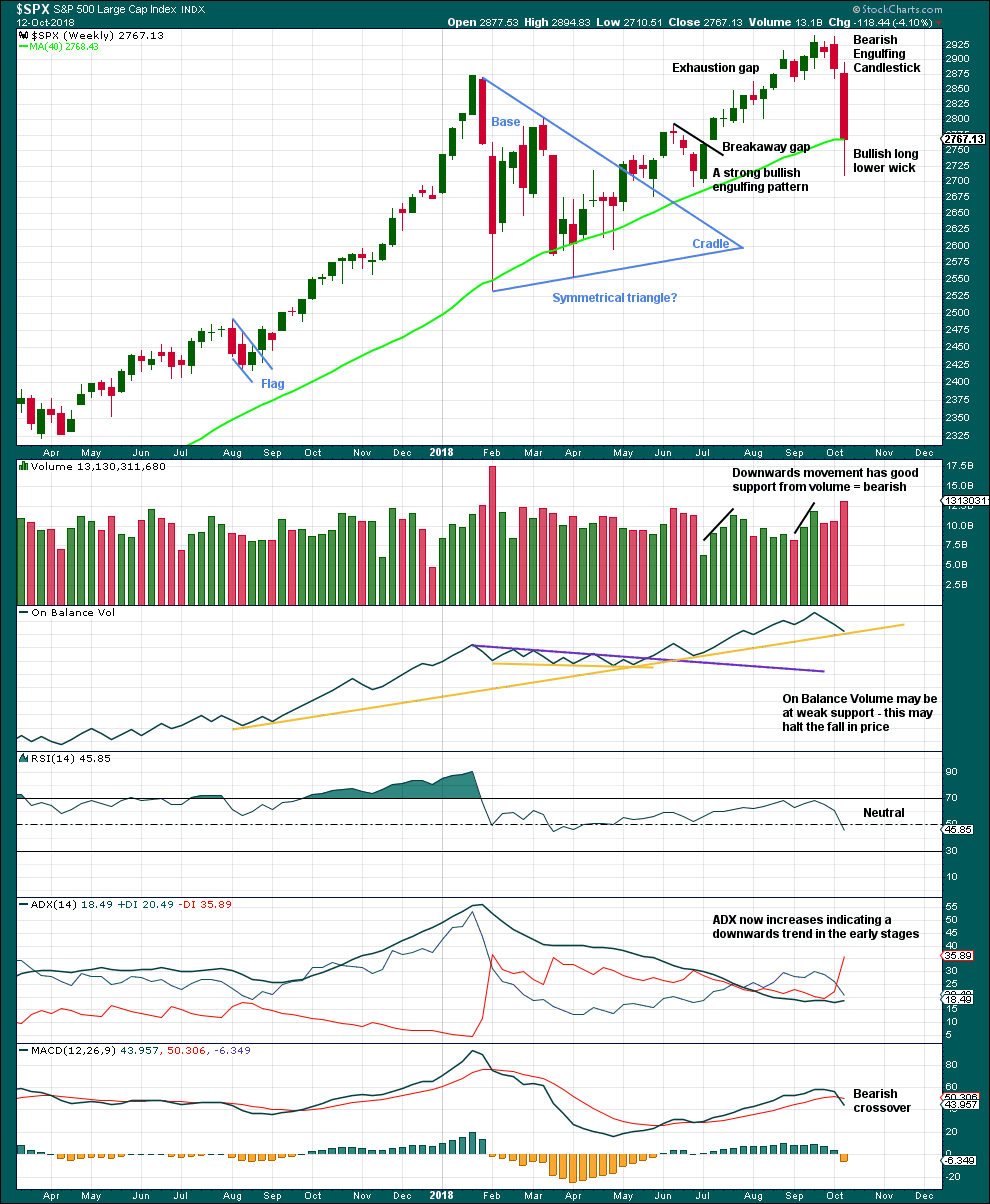
Click chart to enlarge. Chart courtesy of StockCharts.com.
The symmetrical triangle base distance is 340.18. Added to the breakout point of 2,704.54 this gives a target at 3,044.72. This target was not met; it was too optimistic.
The long lower wick on this weekly candlestick suggests a bounce next week.
DAILY CHART
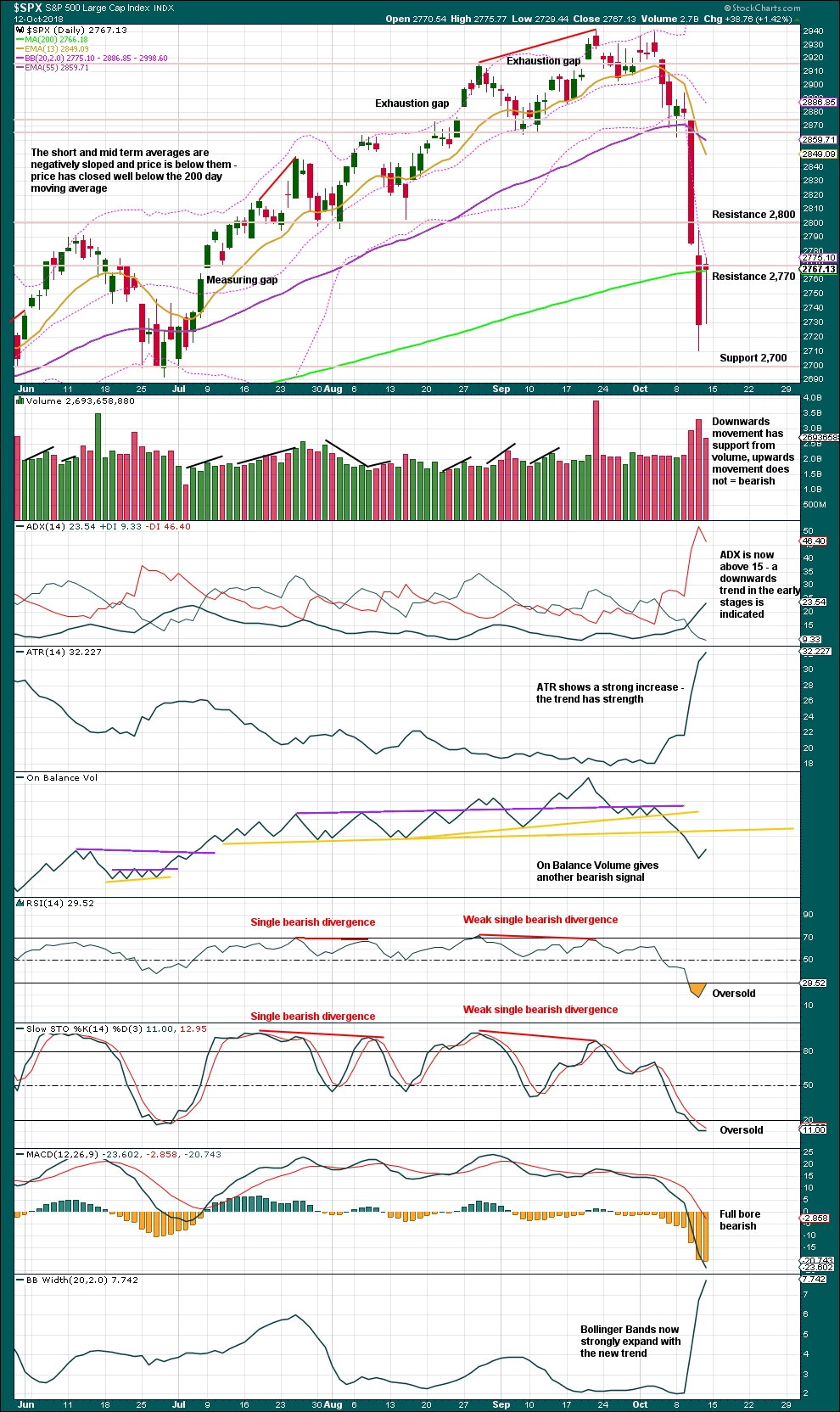
Click chart to enlarge. Chart courtesy of StockCharts.com.
Next support is about 2,700. RSI is now fairly oversold.
There is as yet no bullish divergence between price and either of RSI, Stochastics or On Balance Volume. Nor is there a candlestick reversal pattern. If any of these signals occur, then a bounce may be expected.
For the very short term, the long lower wick on Friday’s candlestick suggests a little more upwards movement to begin next week, but it does not look like a sustained bounce may yet begin. Expect upwards movement to be over within a very few days and be followed by another low to 2,700. Some bullish signals at the next low may develop.
VOLATILITY – INVERTED VIX CHART
WEEKLY CHART
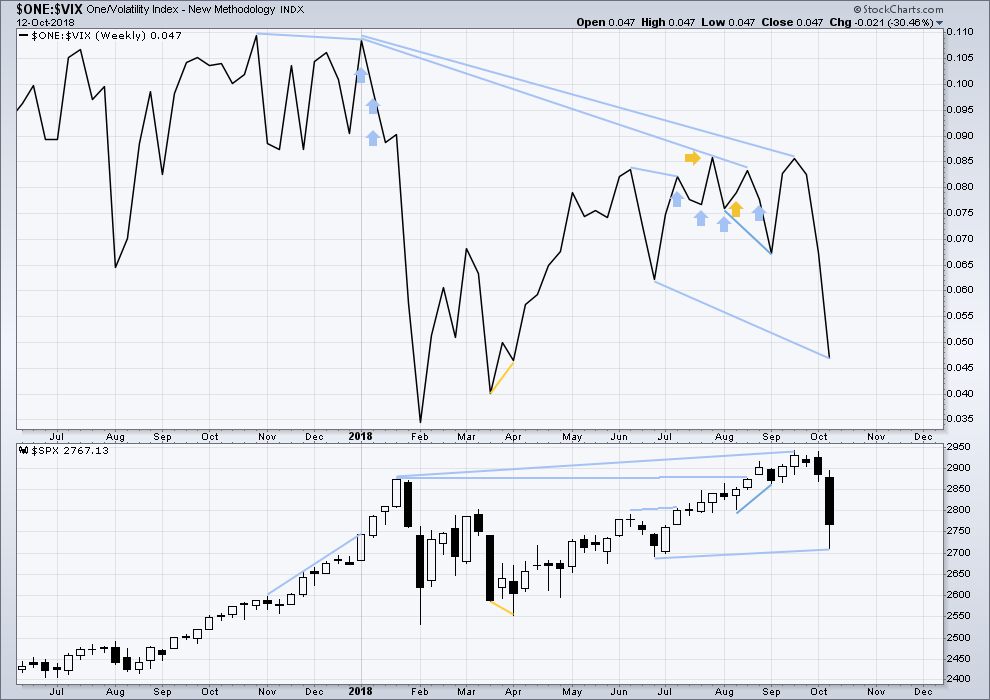
Click chart to enlarge. Chart courtesy of StockCharts.com. So that colour blind members are included, bearish signals
will be noted with blue and bullish signals with yellow.
Primary wave 4 has now arrived and is showing reasonable strength. There is continuing mid term bearish divergence this week with inverted VIX making a new low below the prior swing low of the week beginning 25th June, but price has not yet made a corresponding new low.
As primary wave 4 continues this weekly chart may offer a bullish signal at its end.
DAILY CHART
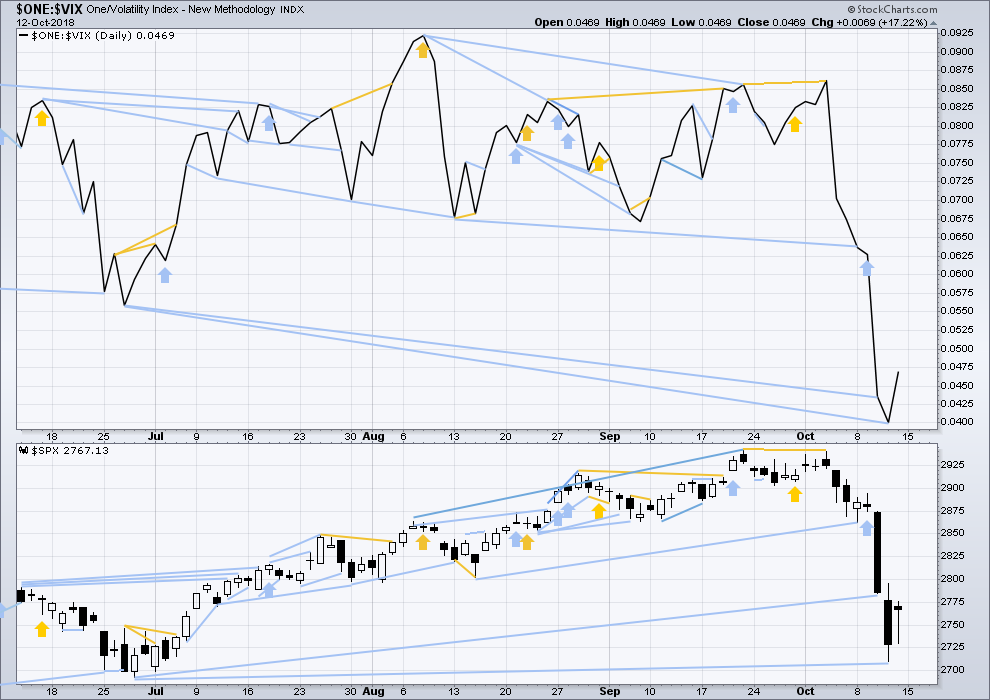
Click chart to enlarge. Chart courtesy of StockCharts.com. So that colour blind members are included, bearish signals
will be noted with blue and bullish signals with yellow.
Normally, volatility should decline as price moves higher and increase as price moves lower. This means that normally inverted VIX should move in the same direction as price.
There is mid term divergence with a new all time high from price not supported by a corresponding new all time high from inverted VIX. This divergence is bearish.
There are now two days in a row of long term bearish divergence between the low for inverted VIX and the prior swing low of the 27th/28th June. Inverted VIX has made new lows, but price has not.
BREADTH – AD LINE
WEEKLY CHART
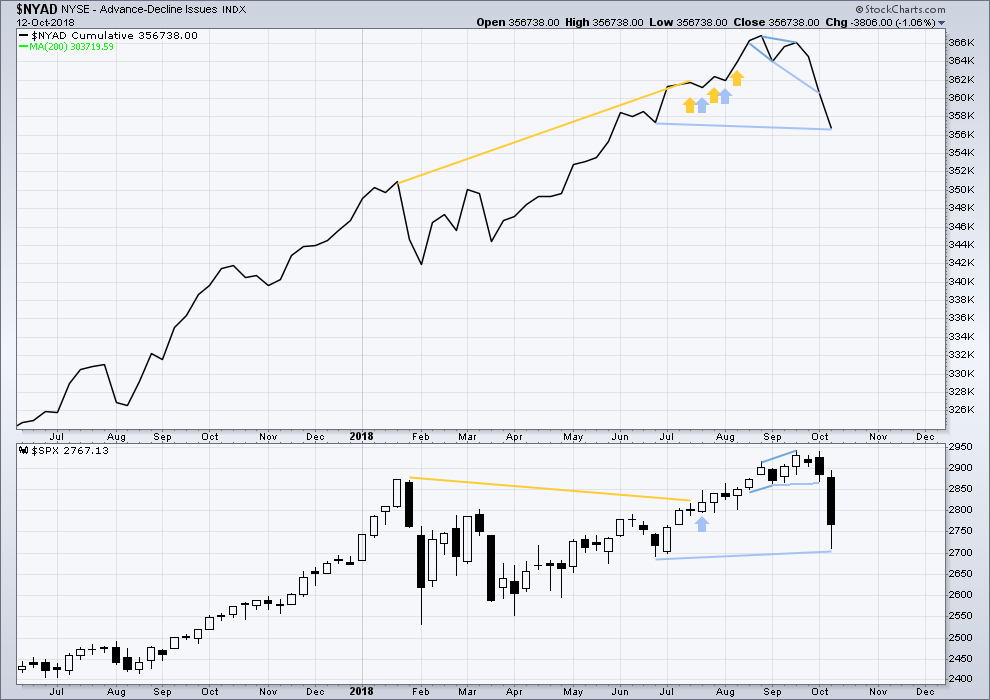
Click chart to enlarge. Chart courtesy of StockCharts.com.
When primary wave 3 comes to an end, it may be valuable to watch the AD line at the weekly time frame as well as the daily.
This week the AD line has made a slight new low below the prior swing low of the week beginning 25th June, but price has not. This mid term divergence is bearish, but it is weak.
DAILY CHART
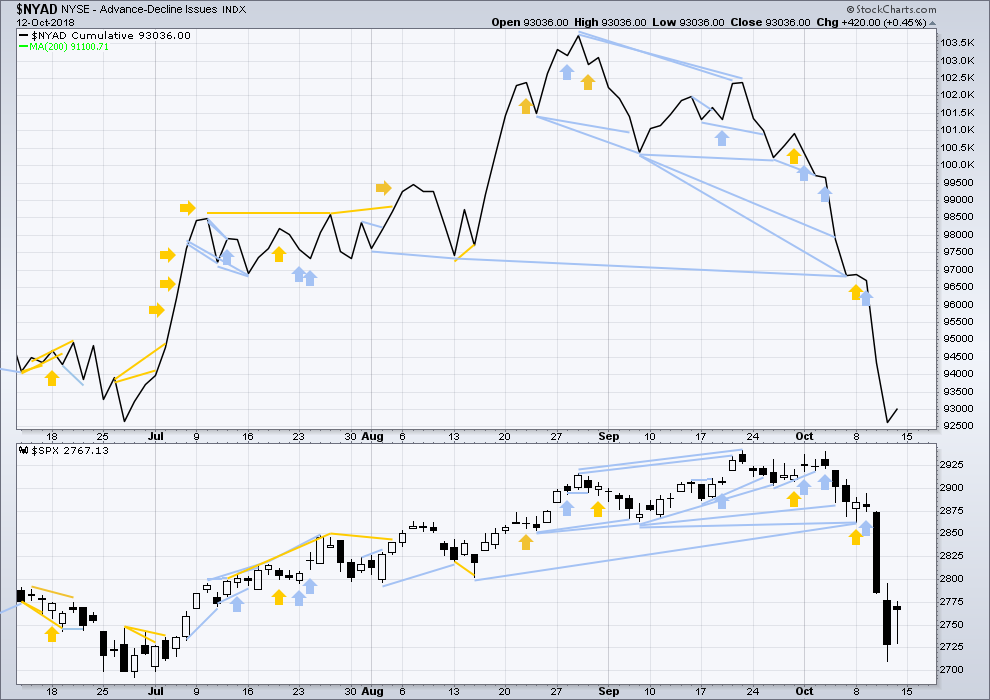
Click chart to enlarge. Chart courtesy of StockCharts.com.
There is normally 4-6 months divergence between price and market breadth prior to a full fledged bear market. This has been so for all major bear markets within the last 90 odd years. With no longer term divergence yet at this point, any decline in price should be expected to be a pullback within an ongoing bull market and not necessarily the start of a bear market. New all time highs from the AD line on the 29th of August means that the beginning of any bear market may be at the end of December 2018, but it may of course be a lot longer than that. My next expectation for the end of this bull market may now be October 2019.
Because there is less than 4 months of bearish divergence between price and the AD line, the current strong fall in price is expected to be only a primary degree correction and not the start of a bear market. The conditions for a full fledged bear market do not yet exist.
Breadth should be read as a leading indicator.
There is no new short term divergence between price and the AD line.
Both mid and small caps for Friday have long lower wicks. This may indicate a small bounce to continue for a very few days.
DOW THEORY
The following lows need to be exceeded for Dow Theory to confirm the end of the bull market and a change to a bear market:
DJIA: 23,344.52.
DJT: 9,806.79.
S&P500: 2,532.69.
Nasdaq: 6,630.67.
ANALYSIS OF INTERMEDIATE WAVE (4)
TECHNICAL ANALYSIS

Click chart to enlarge. Chart courtesy of StockCharts.com.
Intermediate wave (4) was a large symmetrical triangle. The deepest wave was the first wave. At its low there was a clear candlestick reversal pattern and bullish divergence between price and Stochastics.
RSI barely managed to reach into oversold.
The current correction for primary wave 4 may behave differently, but there should be some similarities.
It is expected that primary wave 4 may be stronger than intermediate wave (4).
VIX
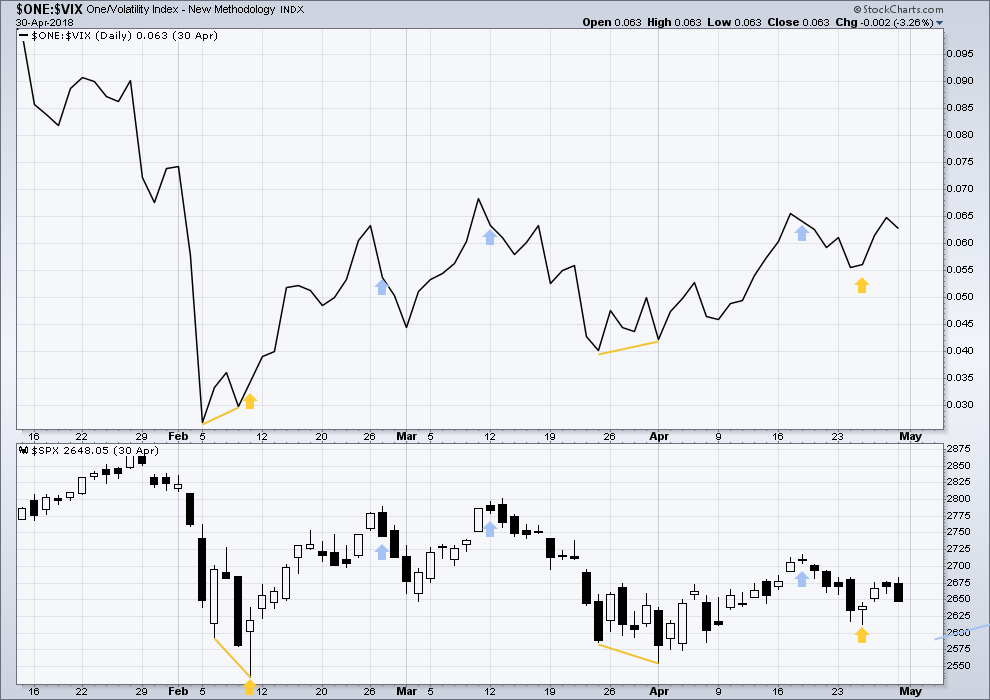
Click chart to enlarge. Chart courtesy of StockCharts.com.
This is a daily chart.
At the two major lows within intermediate wave (4), inverted VIX exhibited single short term bullish divergence.
At highs within intermediate wave (4), inverted VIX exhibited one single day bullish divergence with price.
AD LINE
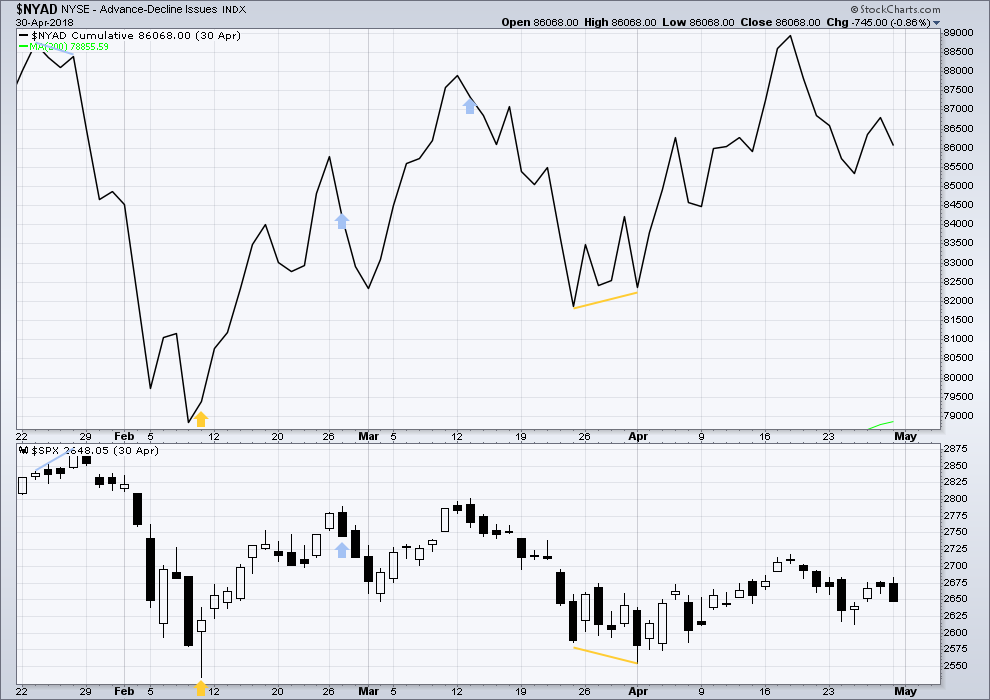
Click chart to enlarge. Chart courtesy of StockCharts.com.
This is a daily chart.
At the two major lows within intermediate wave (4), there was bullish divergence between price and the AD line. At the two major highs within intermediate wave (4), there was each one instance of single day bearish divergence.
GOLD
A small sideways consolidation was expected to unfold for a fourth wave. This is exactly what is happening.
Summary: The sideways consolidation may continue for another one to two days. It may reach as low as 1,210, but should not move below 1,207.78. Thereafter, upwards movement may resume towards a short term target about 1,246.
The final target for this bounce to end is at strong resistance about 1,305 – 1,310.
Grand SuperCycle analysis is here.
Last historic analysis with monthly charts is here.
There are four remaining weekly wave counts at this time for cycle wave b: a triangle, a flat, a combination, and a double zigzag.
At this stage, they will now be presented roughly in order of probability. The triangle and the double zigzag wave counts have about an even probability; the combination and flat wave counts now look less likely.
MAIN ELLIOTT WAVE COUNT
WEEKLY CHART – TRIANGLE
Cycle wave b may be an incomplete regular contracting triangle. Primary wave E may not move beyond the end of primary wave C above 1,365.68. Within primary wave E, intermediate wave B may not move beyond the start of intermediate wave A below 1,160.75.
Four of the five sub-waves of a triangle must be zigzags, with only one sub-wave allowed to be a multiple zigzag. Wave C is the most common sub-wave to subdivide as a multiple, and this is how primary wave C for this example fits best. Primary wave E would most likely be a single zigzag. It is also possible that it may subdivide as a triangle to create a rare nine wave triangle.
There are no problems in terms of subdivisions or rare structures for this wave count. It has an excellent fit and so far a typical look.
A channel is drawn on all charts about the downwards wave of primary wave D. Here, it is labelled a best fit channel. This channel is now fully breached with a full daily candlestick above and not touching it, providing reasonable confidence in this weekly triangle wave count and the double zigzag count, and putting doubt on the combination and flat wave counts.
Primary wave E may now continue higher as a large three wave structure.
DAILY CHART – TRIANGLE
Primary wave D may be complete.
Minor wave 1 may have been over on the 22nd of August.
Minor wave 2 may be a complete expanded flat correction.
Minor wave 3 may only subdivide as an impulse. So far that would be incomplete. A target is calculated for minor wave 3 to end using the most common Fibonacci ratio to minor wave 1. The next target would be about 1,287 where minor wave 3 would reach 2.618 the length of minor wave 1.
Draw an Elliott channel about minor wave 3. Draw the first trend line from the ends of minute waves i to iii, then place a parallel copy on the low of minute wave ii. Minute wave v may end about the upper edge of this channel. If minute wave v exhibits typical commodity like behaviour, then it may be very strong and may end with a strong overshoot of the i-iii trend line.
A target for primary wave E is the strong zone of resistance about 1,305 to 1,310. Primary wave E is most likely to subdivide as a zigzag (although it may also subdivide as a triangle to create a rare nine wave triangle), and it should last at least a Fibonacci 13 weeks. It may also last a total Fibonacci 21 or 34 weeks. So far it has lasted only 8 weeks. Primary wave E may not move beyond the end of primary wave C above 1,365.68.
WEEKLY CHART – DOUBLE ZIGZAG
It is also possible that cycle wave b may be a double zigzag or a double combination.
The first zigzag in the double is labelled primary wave W. This has a good fit.
The double may be joined by a corrective structure in the opposite direction, a triangle labelled primary wave X. The triangle would be about three quarters complete.
Within the triangle of primary wave X, intermediate wave (C) should be complete. Within intermediate wave (D), minor wave B may not move beyond the start of minor wave A below 1,160.75.
Intermediate wave (D) would most likely subdivide as a single zigzag. The subdivisions at the daily chart level for this wave count would be the same as for the first triangle wave count above; a zigzag unfolding higher would be labelled A-B-C.
This wave count may now expect choppy overlapping movement in an ever decreasing range for several more months.
Primary wave Y would most likely be a zigzag because primary wave X would be shallow; double zigzags normally have relatively shallow X waves.
Primary wave Y may also be a flat correction if cycle wave b is a double combination, but combinations normally have deep X waves. This would be less likely.
This wave count has good proportions and no problems in terms of subdivisions.
WEEKLY CHART – COMBINATION
If cycle wave b is a combination, then the first structure in a double may be a complete zigzag labelled primary wave W.
The double may be joined by a three in the opposite direction, a zigzag labelled primary wave X.
The second structure in the double may be a flat correction labelled primary wave Y. My research on Gold so far has found that the most common two structures in a double combination are one zigzag and one flat correction. I have found only one instance where a triangle unfolded for wave Y. The most likely structure for wave Y would be a flat correction by a very wide margin, so that is what this wave count shall expect.
Within a flat correction for primary wave Y, the current downwards wave of intermediate wave (B) may be a double zigzag. Intermediate wave (B) must retrace a minimum 0.9 length of intermediate wave (A) at 1,147.34. Intermediate wave (B) may move beyond the start of intermediate wave (A) as in an expanded flat.
Because the minimum requirement for intermediate wave (B) is not yet met, this wave count requires that intermediate wave (B) continues lower. This is the most immediately bearish of all four weekly wave counts.
When intermediate wave (B) is complete, then intermediate wave (C) would be expected to make at least a slight new high above the end of intermediate wave (A) at 1,365.68 to avoid a truncation. Primary wave Y would be most likely to end about the same level as primary wave W at 1,374.91, so that the whole structure takes up time and moves price sideways, as that is the purpose of double combinations.
While double combinations are very common, triples are extremely rare. I have found no examples of triple combinations for Gold at daily chart time frames or higher back to 1976. When the second structure in a double is complete, then it is extremely likely (almost certain) that the whole correction is over.
DAILY CHART – COMBINATION
Intermediate wave (B) may be unfolding lower as a double zigzag.
The first zigzag may be complete, labeled minor wave W. The double may now be joined by an incomplete three in the opposite direction, a zigzag labelled minor wave X. X waves within double zigzags are usually fairly shallow and often also reasonably brief. Minor wave X may end fairly soon.
This wave count now expects that the upwards breakout may turn out to be false.
WEEKLY CHART – FLAT
It is possible that cycle wave b may be a flat correction. Within a flat correction, primary wave B must retrace a minimum 0.9 length of primary wave A at 1,079.13 or below. Primary wave B may make a new low below the start of primary wave A at 1,046.27 as in an expanded flat correction.
Only a new low reasonably below 1,123.08 would provide reasonable confidence in this wave count.
Intermediate wave (C) must subdivide as a five wave structure; it may be unfolding as an impulse. Within intermediate wave (C), minor waves 1 through to 4 may be complete. If it continues further, then minor wave 4 may not move into minor wave 1 price territory above 1,307.09.
The blue channel here is drawn using Elliott’s first technique. Minor wave 4 would be most likely to remain contained within this channel, and may find resistance about the upper edge if it gets there. A strong breach of this channel by upwards movement would reduce the probability of this wave count.
Minor wave 2 was a double zigzag lasting nine weeks. Minor wave 4 exhibits little alternation as a single zigzag and reasonable proportion lasting eight weeks so far.
TECHNICAL ANALYSIS
WEEKLY CHART

Click chart to enlarge. Chart courtesy of StockCharts.com.
On Balance Volume is lower than its prior point at the end of November 2015. This divergence is extremely bearish but does not rule out a consolidation unfolding here; the divergence does strongly support the Triangle wave count, which expects a consolidation or bounce up to test resistance now and then a continuation of a major bear market. It could also support the flat wave count that allows for a new low below 1,046.27 in coming months.
On Balance Volume has made another new low, but price has not. There is now double bearish divergence between price and On Balance Volume.
The short term volume profile is now bullish. With a bullish long lower wick on the last weekly candlestick, it looks like next week may see price continue higher.
DAILY CHART
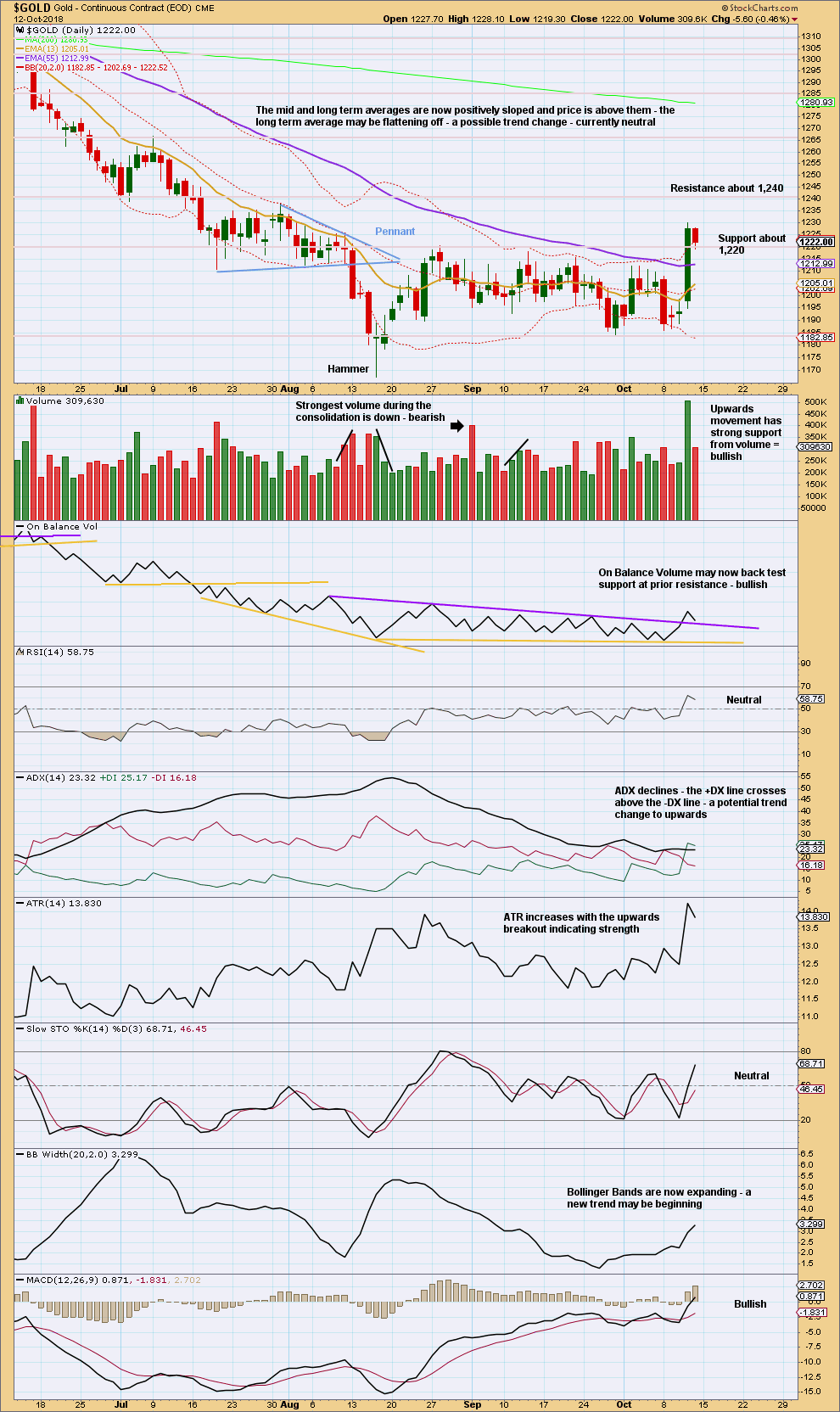
Click chart to enlarge. Chart courtesy of StockCharts.com.
With strong support from volume, Thursday completes an upwards breakout above resistance at 1,220. Support is now being tested on Friday. It would be typical now to see price move up and away.
Price is at support. On Balance Volume is at support. An upwards day on Monday looks most likely.
There is resistance above about 1,240.
The bullish signal from On Balance Volume is strong: the trend line breached was long held and tested multiple times, and it has a shallow slope. This adds confidence in an upwards breakout.
GDX WEEKLY CHART
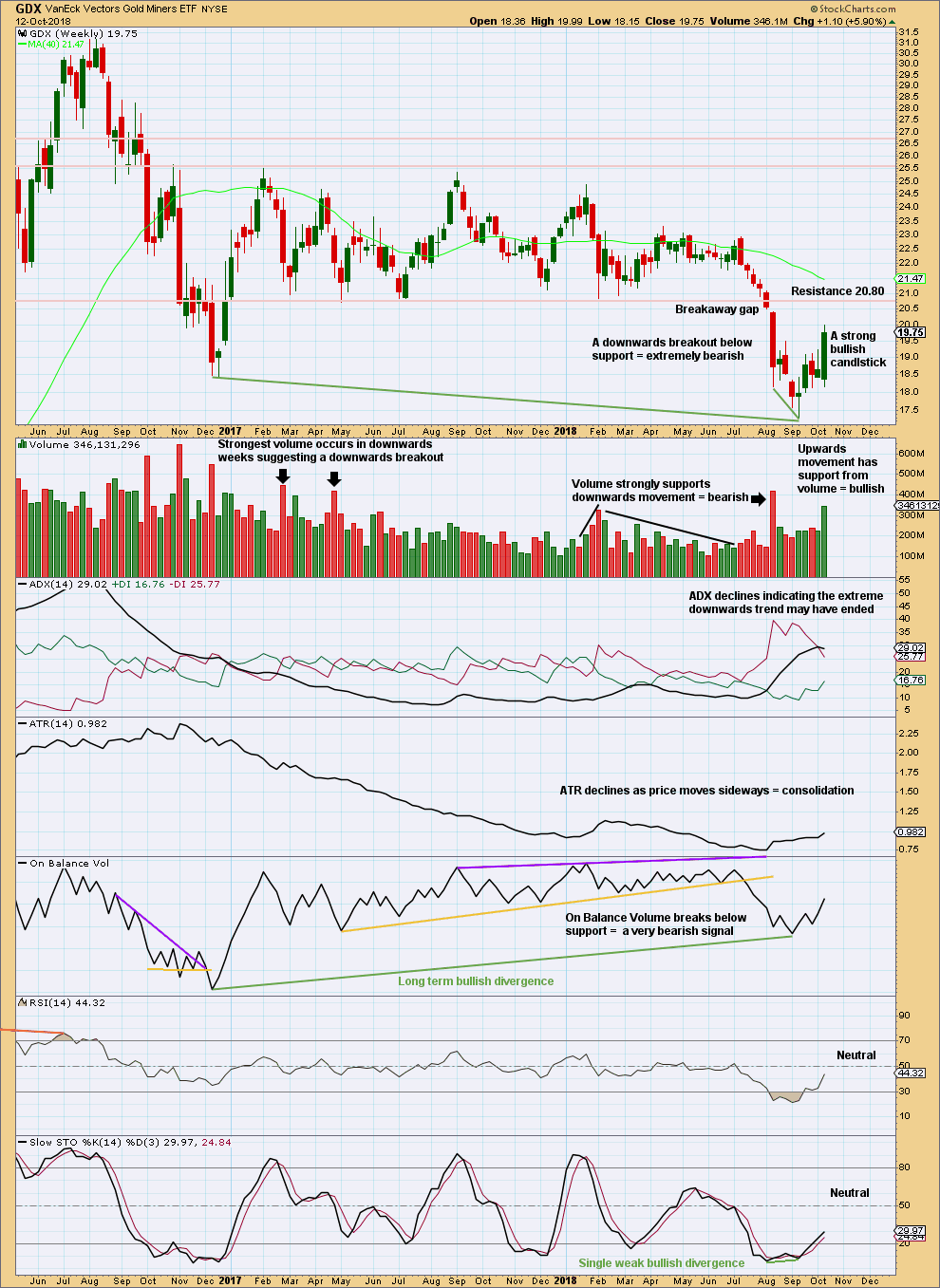
Click chart to enlarge. Chart courtesy of StockCharts.com.
After a breakout, a technical principle is the longer that price consolidates sideways the longer the resulting trend may be expected to be. Also, the longer that price meanders sideways the more energy may be released after a breakout. This is what has happened for GDX.
A target for this downwards trend to end calculated using the measured rule is at 16.02. That is not yet met.
At the weekly chart level, there is a clear downwards breakout with a breakaway gap. As breakaway gaps should not be closed, they may be used to set stops that may be set just above a downwards breakaway gap. The upper edge of the gap is at 20.51.
It looks like upwards movement of the last week may now continue to back test resistance at prior support. When price behaves like this after a clear breakout from a long held consolidation, it offers a low risk high rewards entry opportunity to join a new trend. If price does get up close to 20.80, then it may turn there and move strongly lower.
GDX DAILY CHART
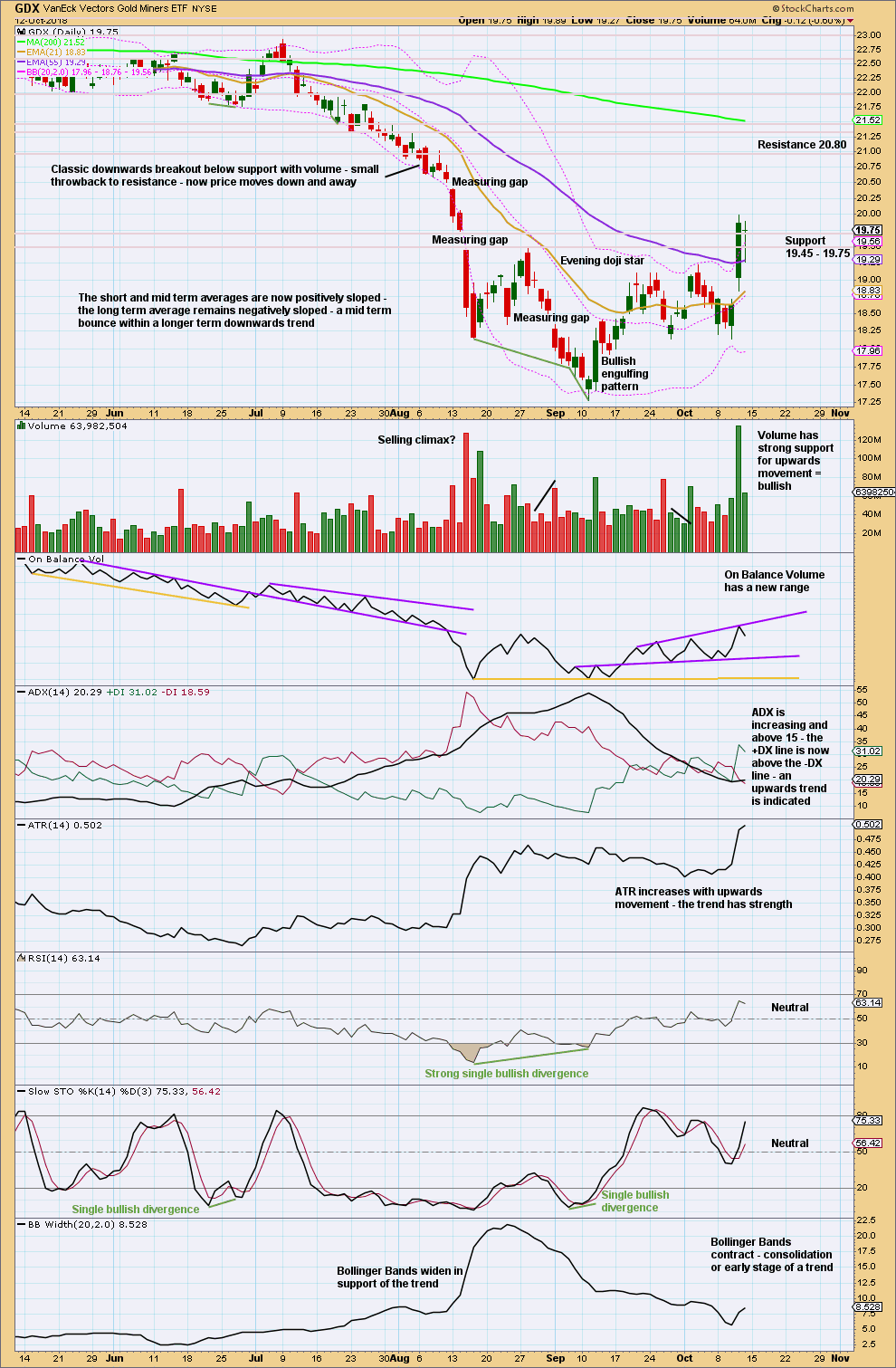
Click chart to enlarge. Chart courtesy of StockCharts.com.
It now looks like GDX may be curving back up to test very strong resistance about 20.80. If it does get up to this point, then that may offer a very good entry point for a short position which may be held for a reasonably long term.
US OIL
Downwards movement was expected for the last week, which is exactly what has happened for US Oil.
Both Elliott wave counts remain valid.
Summary: Sideways and slightly lower movement is expected for next week.
Thereafter, the upwards trend should resume with strength.
Pullbacks may be used as opportunities to join the trend.
MAIN WAVE COUNT
MONTHLY CHART
The bear market for US Oil looks to be over and a new bull market looks to be in its early stages. The prior bearish wave count has been invalidated, leaving only this very bullish wave count.
A huge zigzag down to the last low may be complete and is labelled here Super Cycle wave (II).
Cycle wave b must be seen as complete in August 2013 for this wave count to work. It cannot be seen as complete at the prior major swing high in May 2011.
Cycle wave b is seen as a zigzag, and within it primary wave B is seen as a running contracting triangle. These are fairly common structures, although nine wave triangles are uncommon. All subdivisions fit.
Primary wave C moves beyond the end of primary wave A, so it avoids a truncation. But it does not have to move above the price territory of primary wave B to avoid a truncation, which is an important distinction.
If cycle wave b begins there, then cycle wave c may be seen as a complete five wave impulse.
Super Cycle wave (III) must move beyond the end of Super Cycle wave (I). It must move far enough above that point to allow room for a subsequent Super Cycle wave (IV) to unfold and remain above Super Cycle wave (I) price territory.
Cycle wave I may be incomplete. It may be unfolding as an impulse and may have now moved through the middle portion. Commodities have a tendency to exhibit swift strong fifth waves, and this tendency is especially prevalent for third wave impulses. Intermediate wave (5) to end primary wave 3 may be very swift and strong, ending with a blow off top.
When cycle wave I is complete, then cycle wave II may be a deep correction that may not move beyond the start of cycle wave I below 26.06.
Data from FXCM for USOil does not go back to the beginning of Super Cycle wave (I). Without an accurate known length of Super Cycle wave (I) a target cannot be calculated for Super Cycle wave (III) to end using Fibonacci ratios. The target for Super Cycle wave (III) may be calculated when cycle waves I, II, III and IV within it are complete. That cannot be done for many years.
WEEKLY CHART
Intermediate wave (3) is now complete. There is no Fibonacci ratio between intermediate waves (1) and (3), and intermediate wave (3) is longer than 1.618 the length of intermediate wave (1).
This wave count fits with classic technical analysis at the monthly and daily chart levels.
Intermediate wave (2) was a deep double zigzag. Given the guideline of alternation, intermediate wave (4) may be expected to most likely be a shallow flat, triangle or combination. It may be about even in duration with intermediate wave (2), or it may be a little longer because triangles and combinations are more time consuming structures.
Intermediate wave (4) may be a complete triangle; this looks most likely. If it continues further, then it may end within another very few weeks as a combination; this now looks less likely.
TRIANGLE
Intermediate wave (4) may be a complete triangle.
All triangle sub-waves subdivide into single or multiple zigzags, with only one sub-wave a more complicated multiple. The final wave of minor wave E ends reasonably short of the A-C trend line.
This triangle meets all Elliott wave rules, but it does come to a rather quick conclusion. This is possible, but it does not have a typical look. The probability is now slightly reduced.
If intermediate wave (4) is complete, then intermediate wave (5) has begun. Within intermediate wave (5), a pullback for minor wave 2 may now continue that may not move beyond the start of minor wave 1 below 66.86. Minor wave 2 may now end below the 0.618 Fibonacci ratio of minor wave 1.
While it is possible that minor wave 2 could be over at this week’s low, it would be very brief. Downwards movement has strong support from volume, so it looks like this pullback is not over.
COMBINATION
Intermediate wave (4) may be unfolding as a double combination.
The first structure in a double combination may be a complete zigzag labelled minor wave W. There is a little disproportion within minute wave a between the corrections of minuette waves (ii) and (iv), but this is slight enough to be acceptable for this market.
The double is joined by a complete three in the opposite direction, a zigzag labelled minor wave X. X waves within combinations have no minimum nor maximum allowable length, and may make new price extremes beyond the start of wave W as this one does. The only guideline in terms of depth for X waves is that they are normally very deep.
The second structure in a double combination would most likely be a flat correction as the two most common structures in a double combination are one zigzag and one flat.
Within a possible flat correction for minor wave Y, minute wave a looks like a completed three. Minute wave b has now met the minimum 0.9 length of minute wave a, and it has moved beyond the start of minute wave a, indicating an expanded flat. Minute wave b is within the common range of 1 to 1.38 times the length of minute wave a. Expanded flats are very common structures.
Minute wave c would need to end at least slightly below the end of minute wave a at 64.43 to avoid a truncation and a very rare running flat.
The purpose of the second structure in a double combination is to take up time and move price sideways. To achieve this purpose minor wave Y would be most likely to end about the same level as minor wave W about 63.60.
Minute wave c must subdivide as a five wave structure, most likely an impulse. Within the impulse, so far minuette waves (i) and (ii) may be complete. Within minuette wave (iii), the correction for subminuette wave ii may not move beyond the start of subminuette wave i above 75.28.
TECHNICAL ANALYSIS
MONTHLY CHART
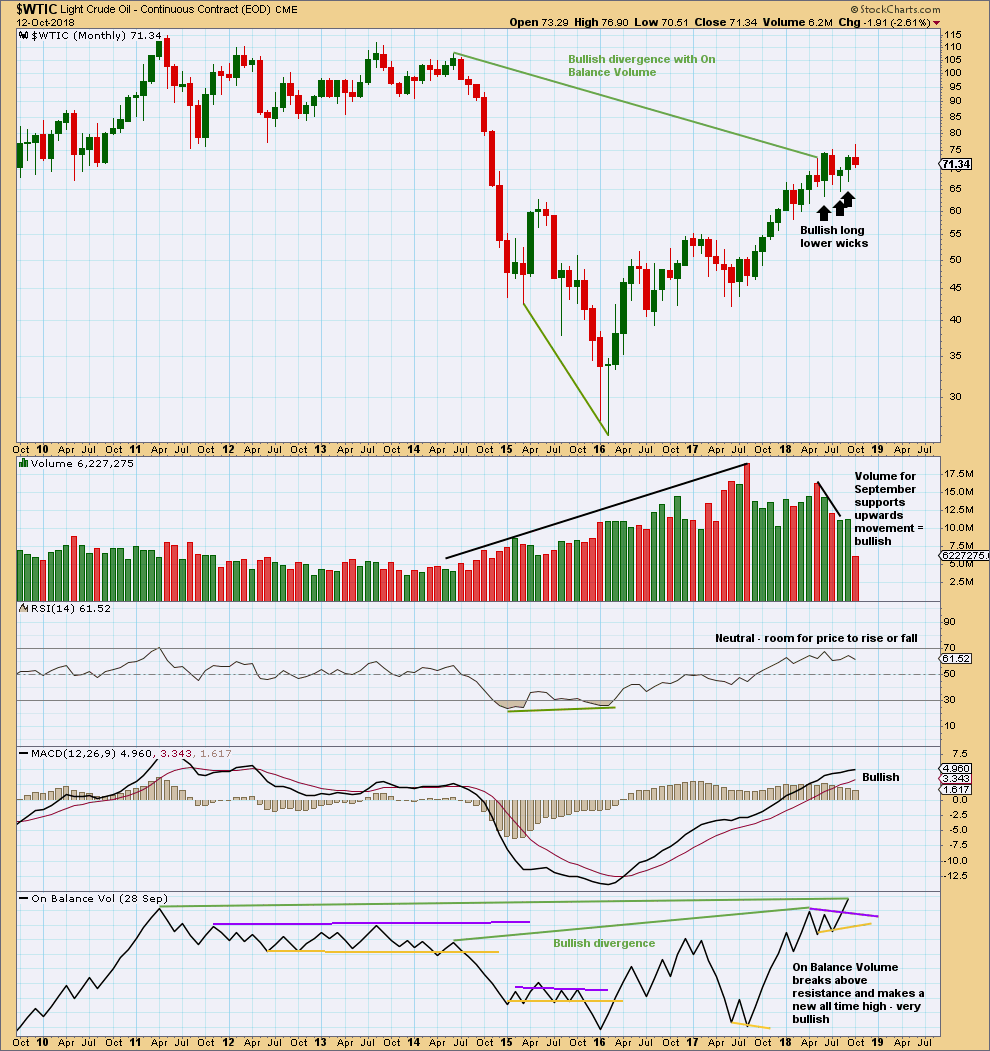
Click chart to enlarge. Chart courtesy of StockCharts.com.
The larger trend remains upwards.
The last three months have seen price move sideways. Three long and lower monthly wicks are bullish. Now September shows support from volume for upwards movement; the short term volume profile is now bullish.
On Balance Volume gives a bullish signal, breaking above resistance. On Balance Volume has also made a new high above the prior high of May 2011. As On Balance Volume should be read as a leading indicator, price may follow through with a new high above May 2011’s high.
WEEKLY CHART
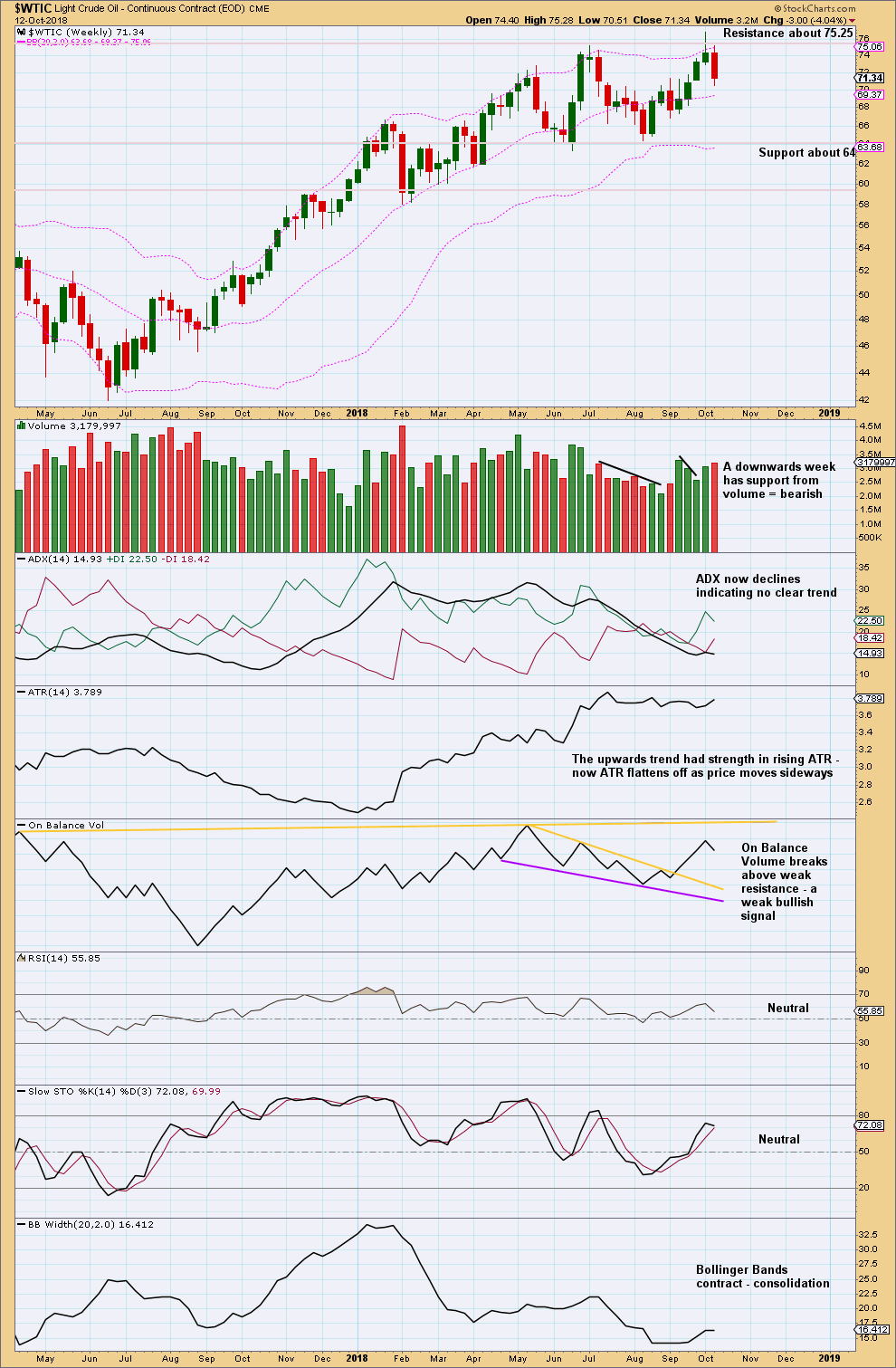
Click chart to enlarge. Chart courtesy of StockCharts.com.
It is upwards weeks during the consolidation that have strongest support from volume. This looks like a continuation pattern. The breakout would most likely be upwards.
The Shooting Star candlestick pattern is now followed by a Bearish Engulfing pattern. This indicates more downwards movement is likely.
The short term volume profile is slightly bearish.
DAILY CHART
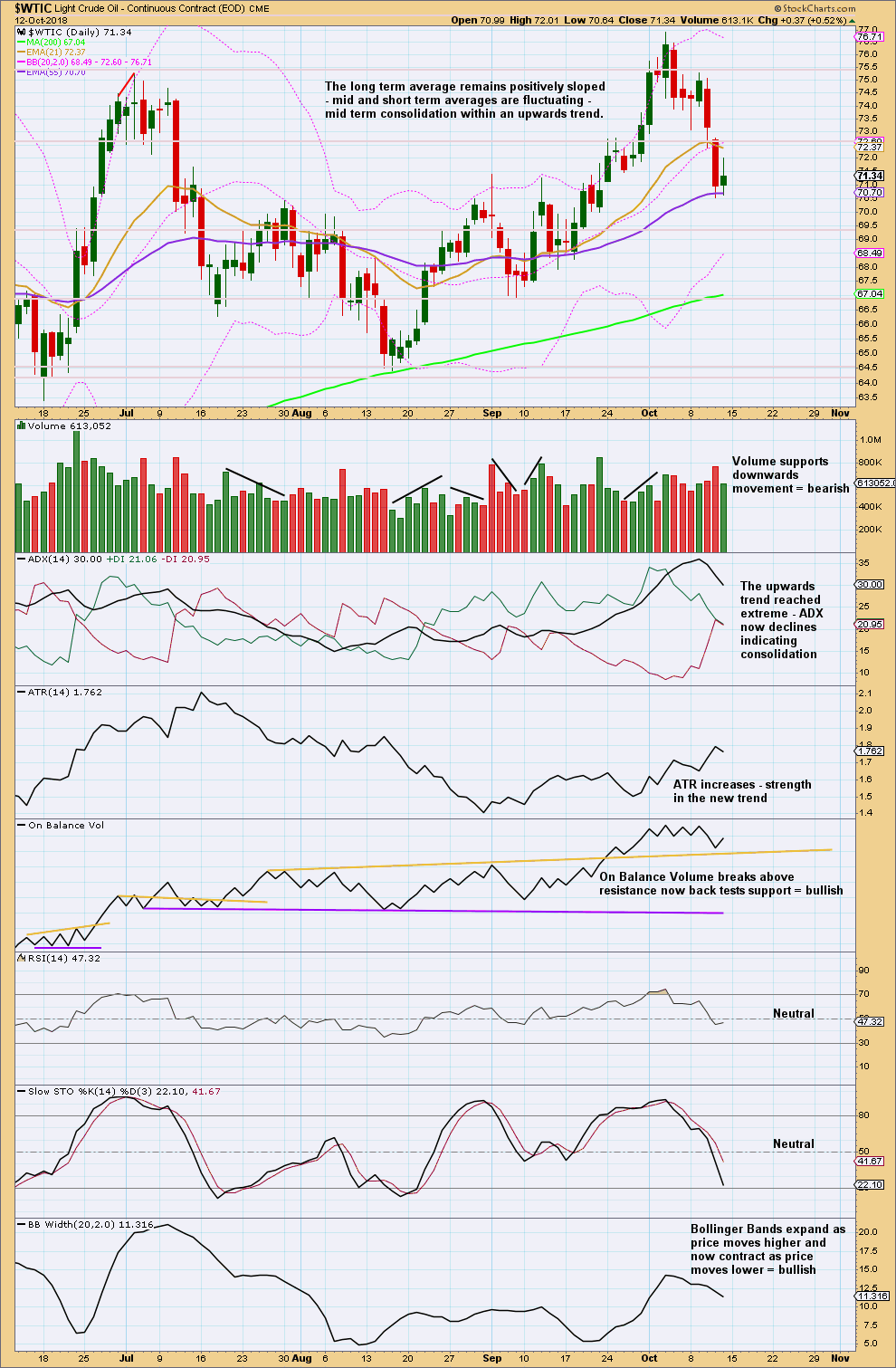
Click chart to enlarge. Chart courtesy of StockCharts.com.
Downwards movement has support from volume. The last upwards day does not. Downwards days have a larger range than the last upwards day. More downwards movement overall looks most likely.
Support below is about 69.40. Below that the 200 day moving average may provide support.
—
Always practice good risk management as the most important aspect of trading. Always trade with stops and invest only 1-5% of equity on any one trade. Failure to manage risk is the most common mistake new traders make.

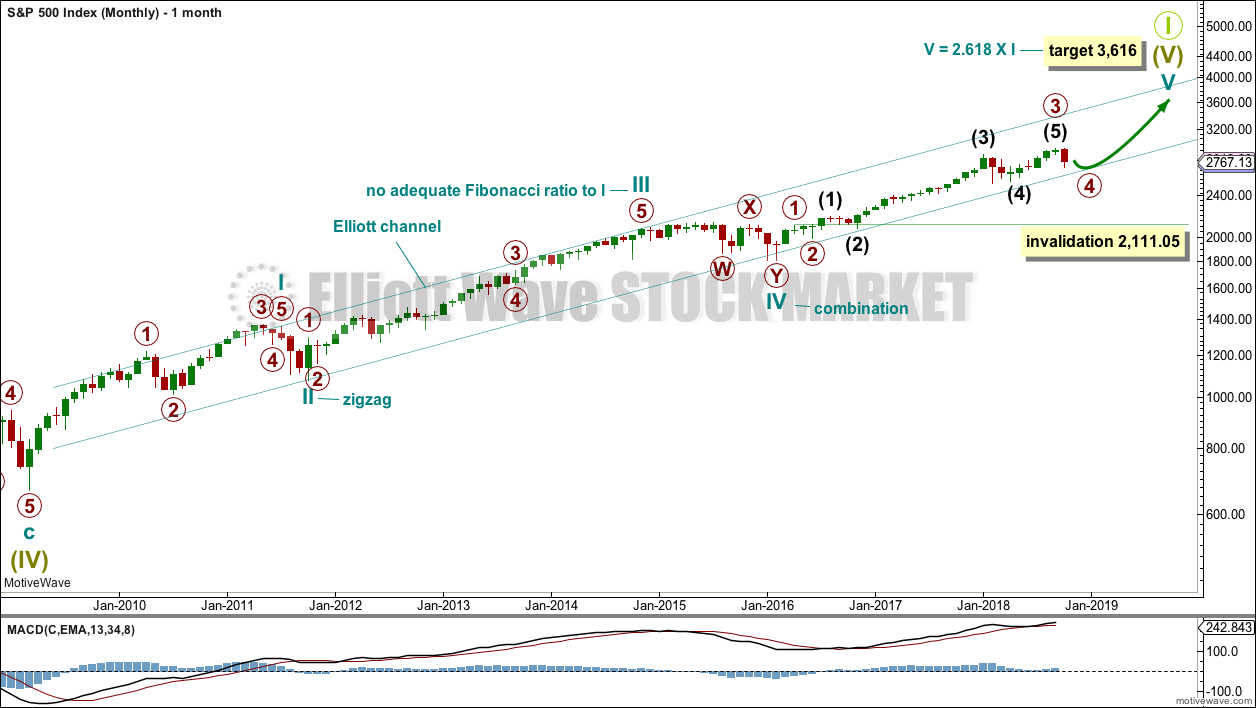
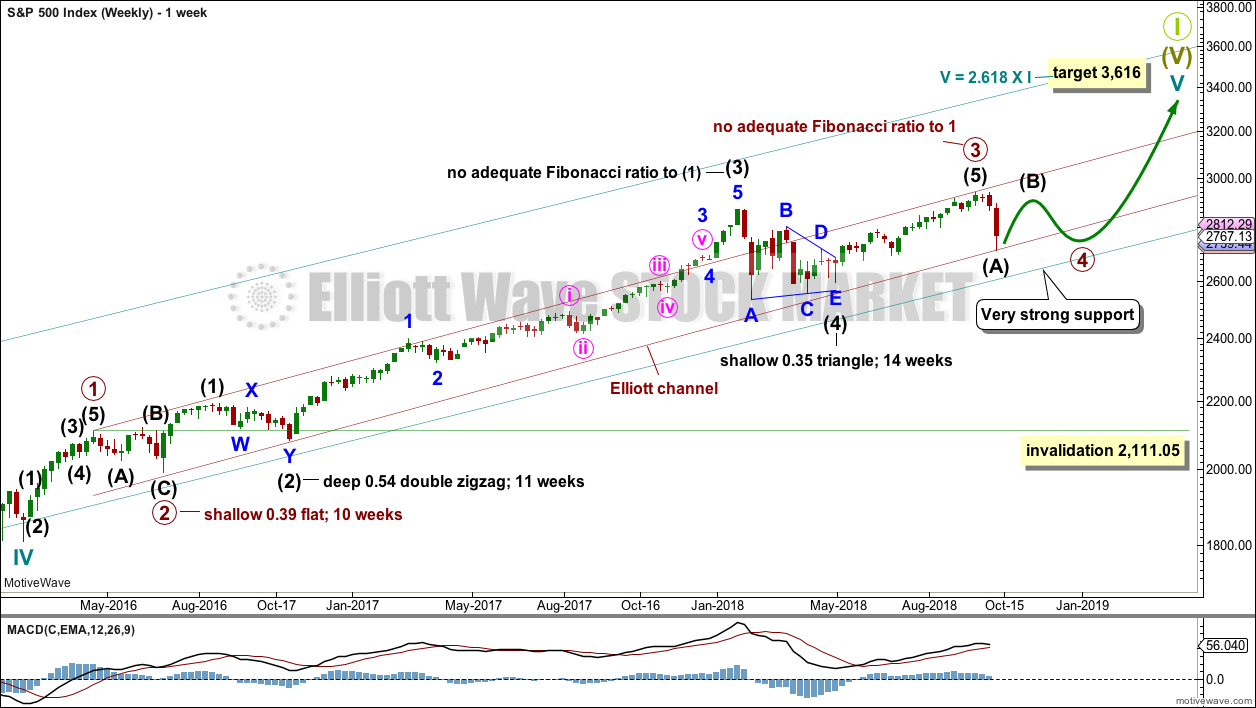
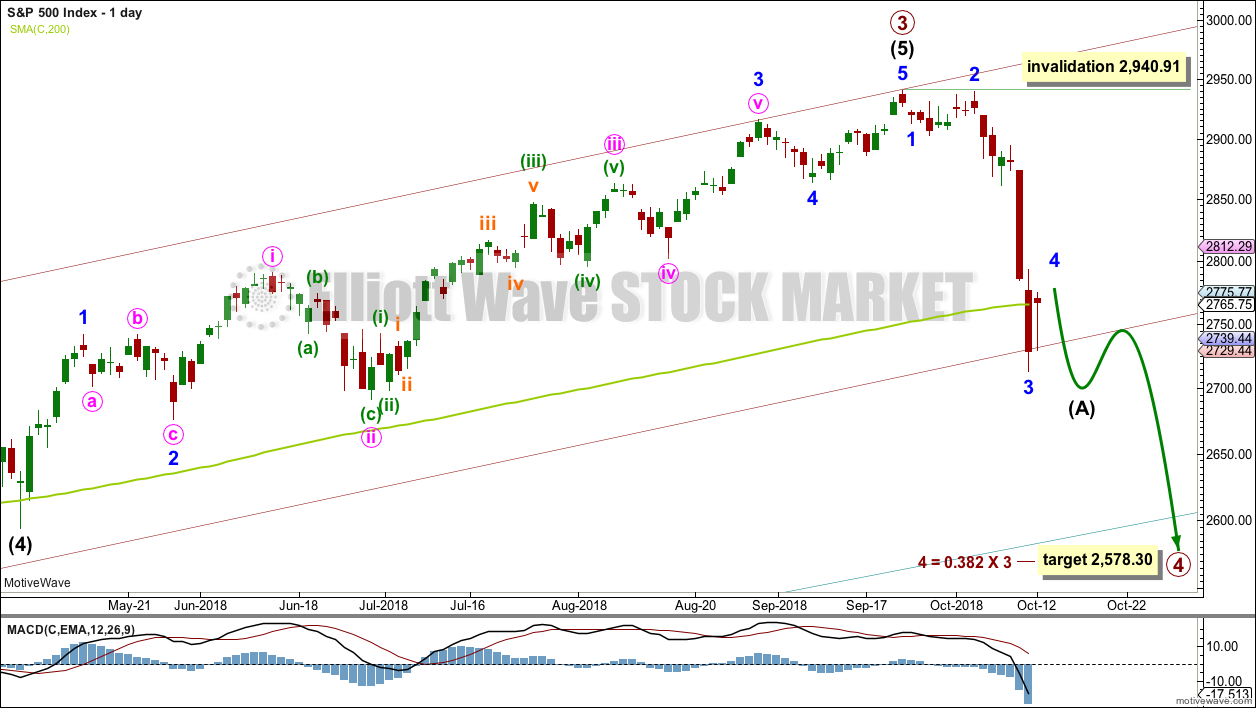
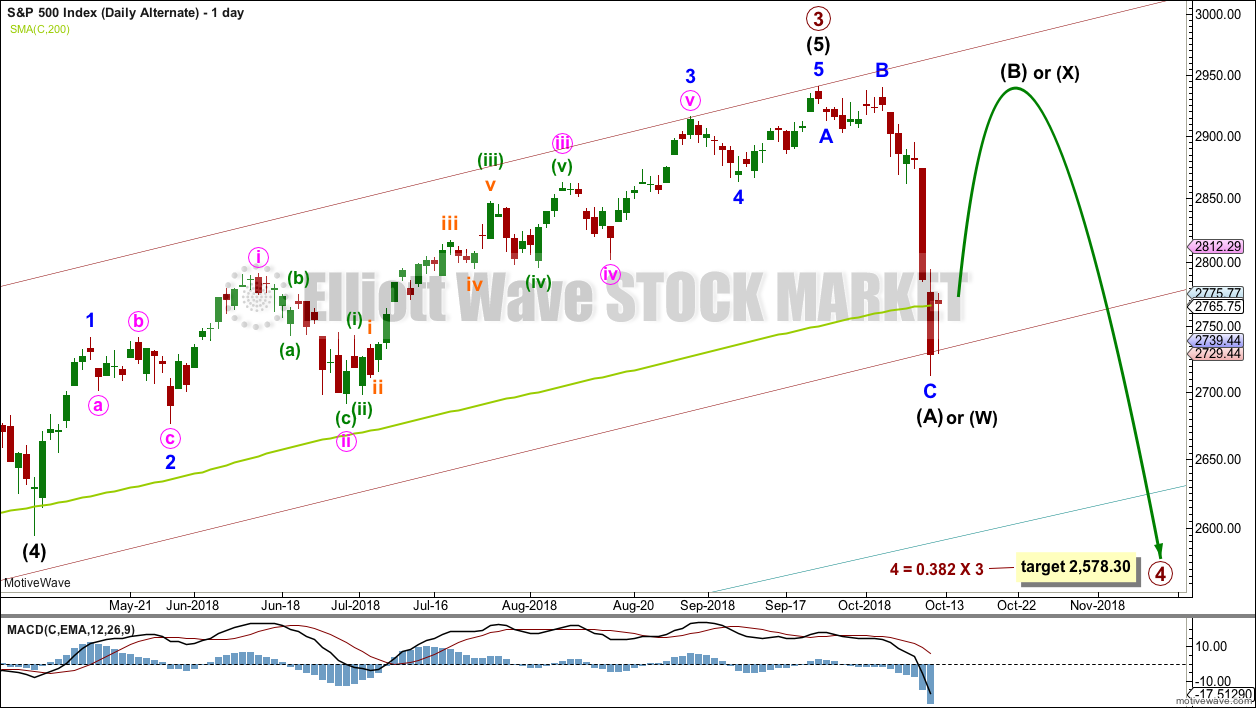
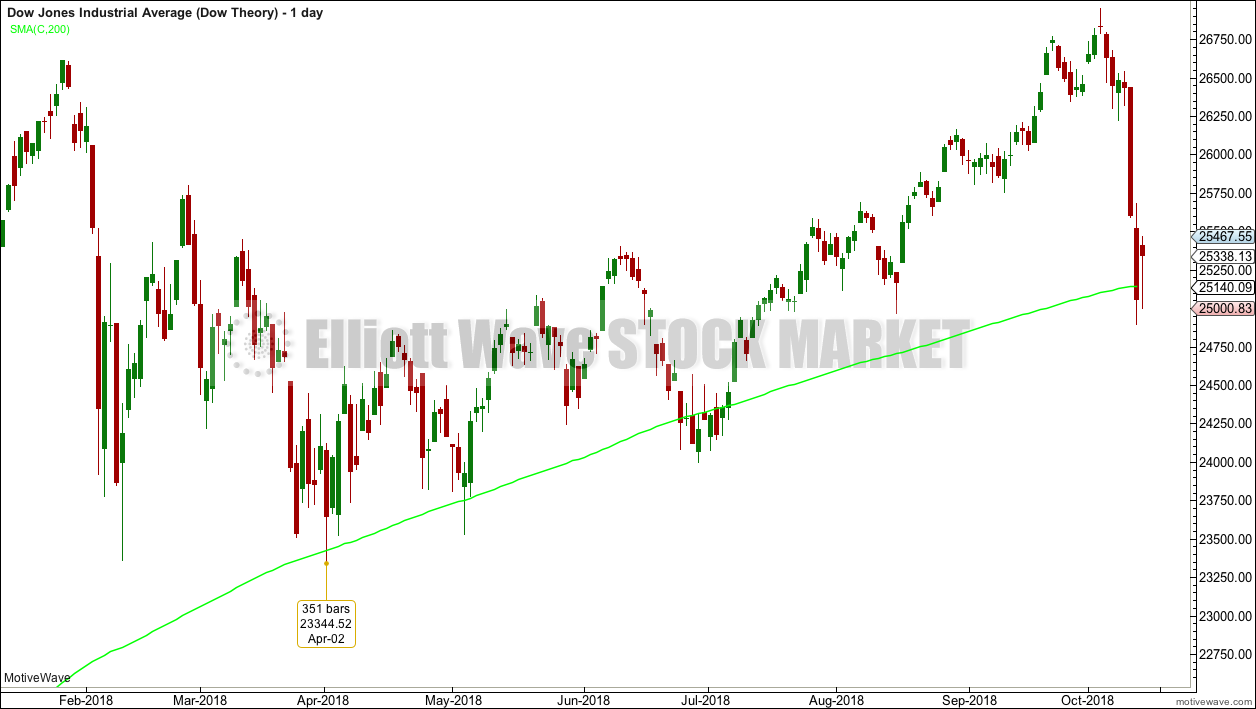
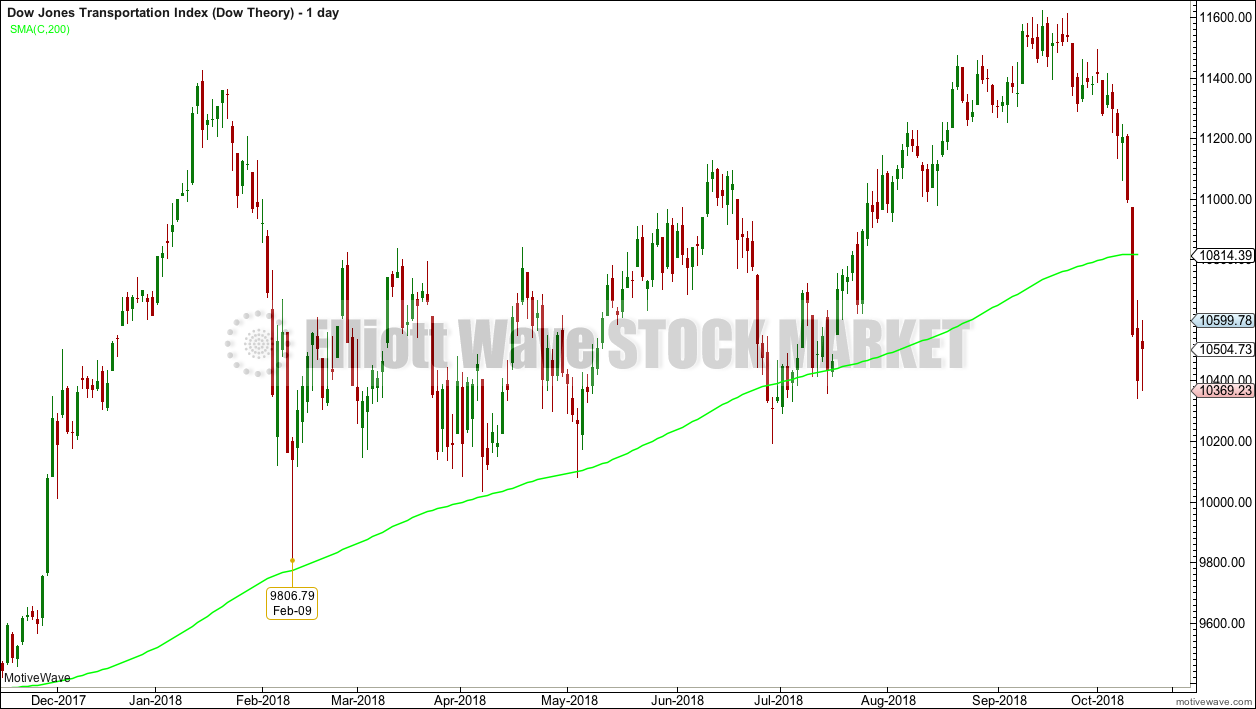
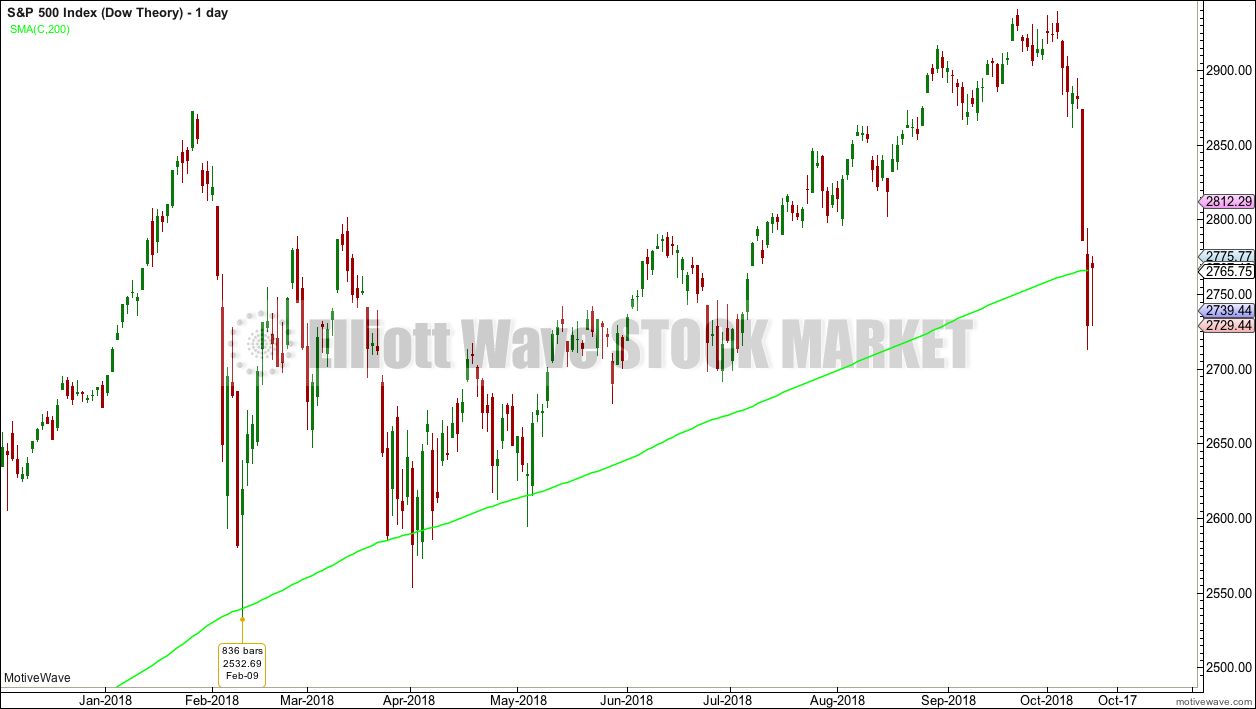


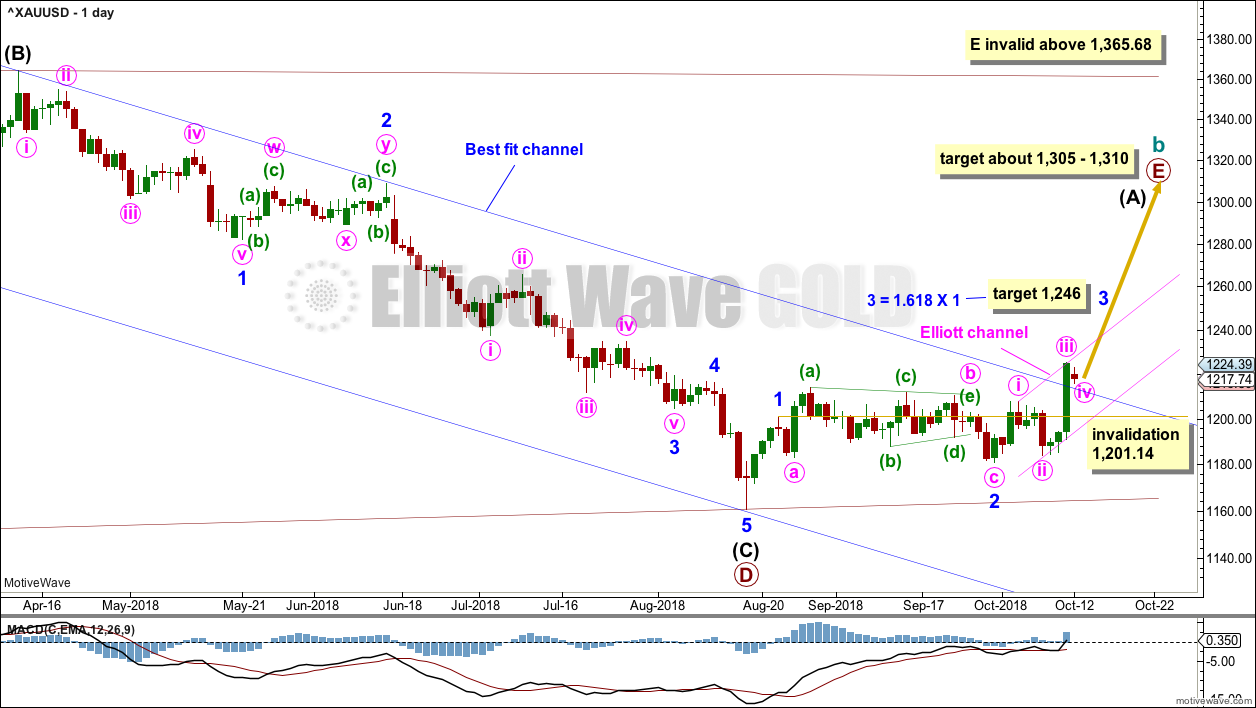
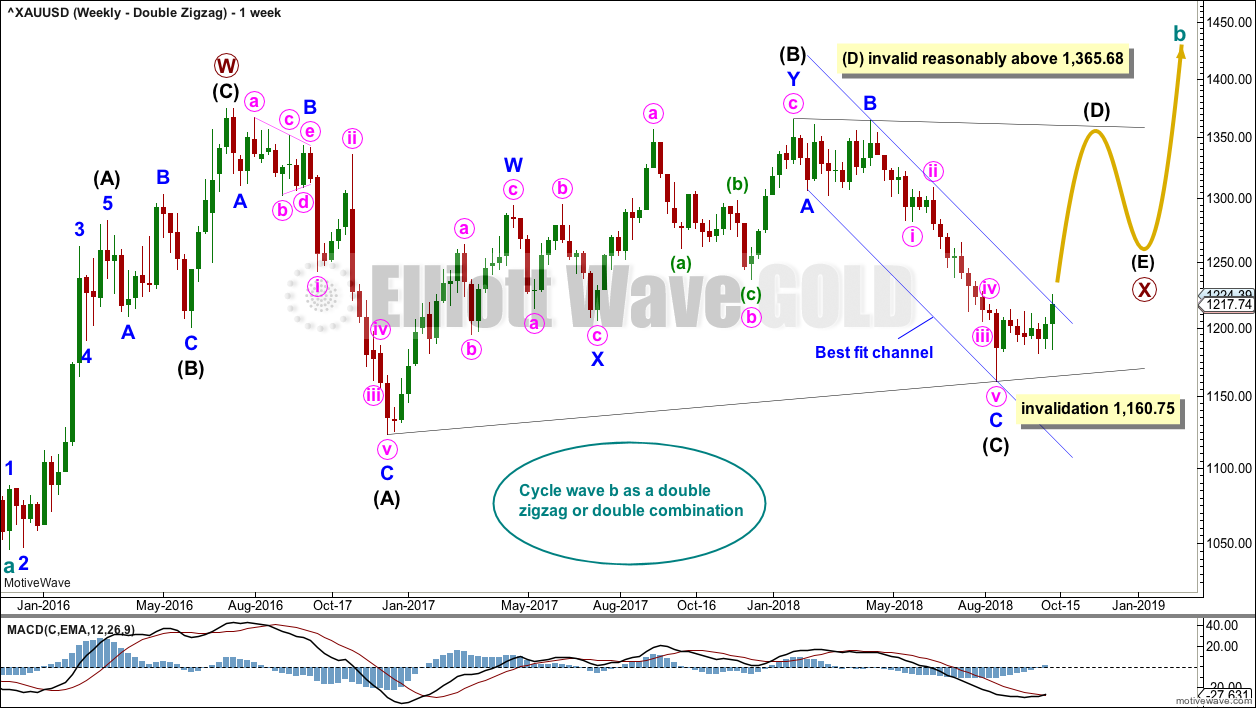
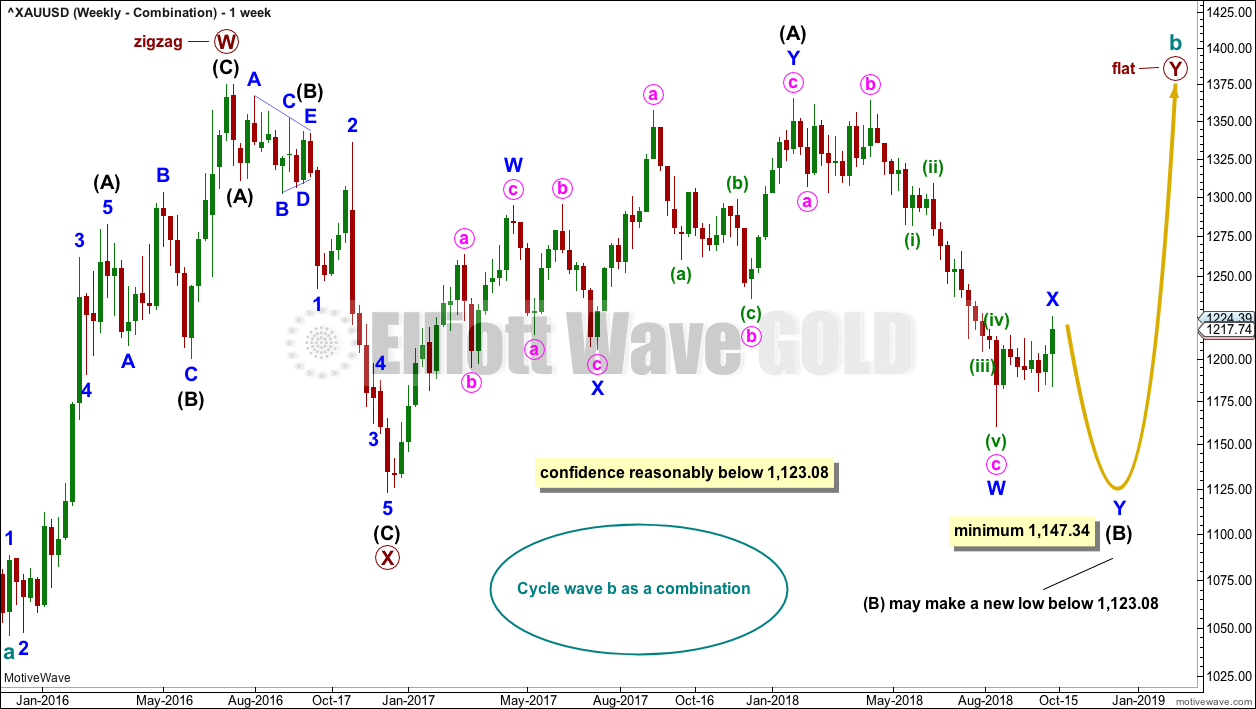
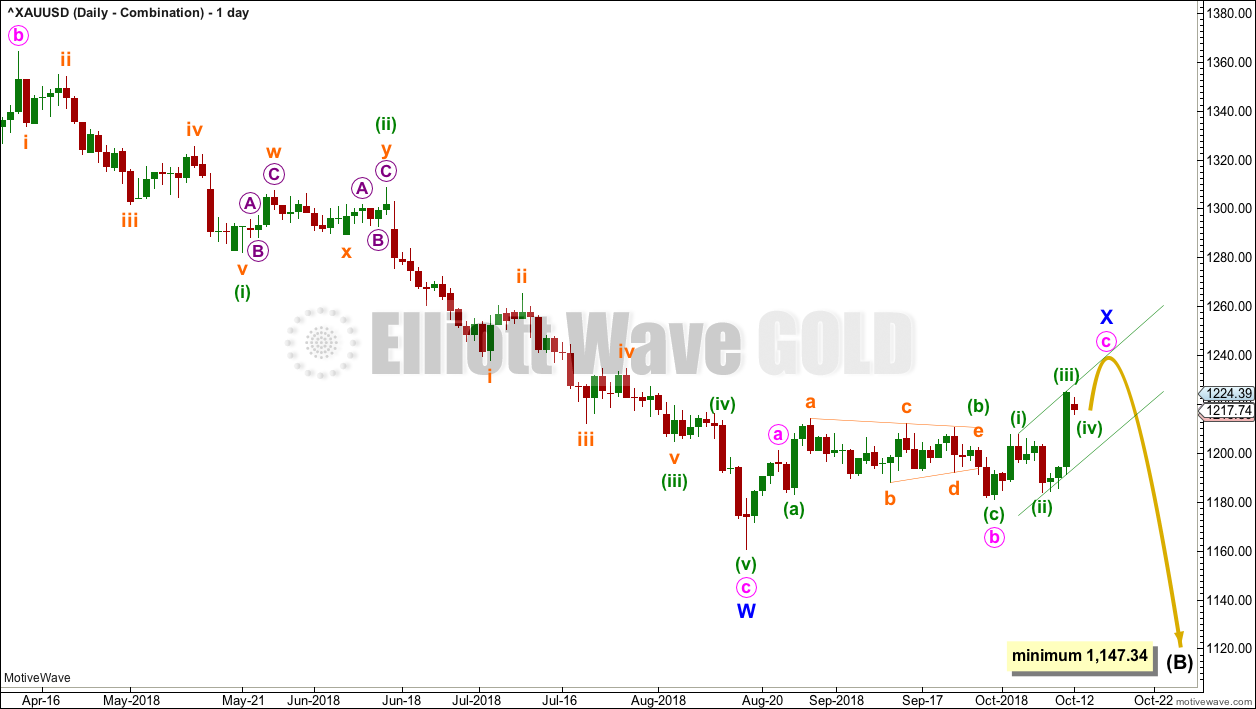
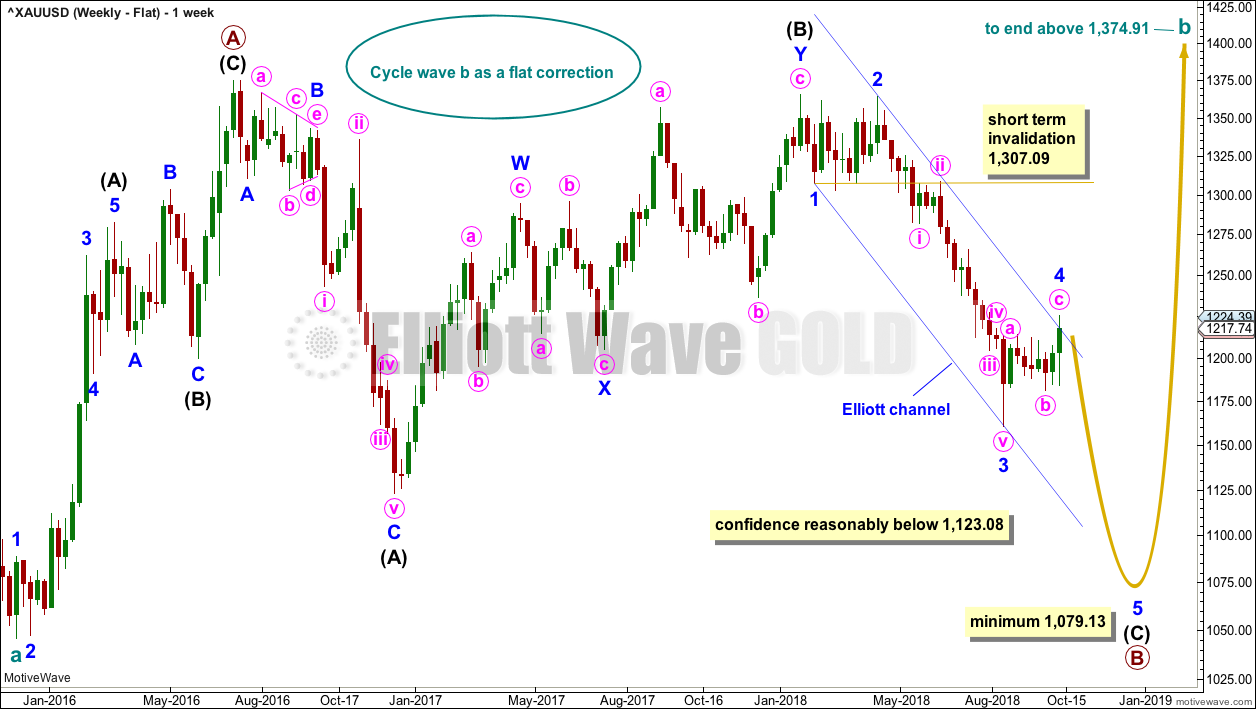
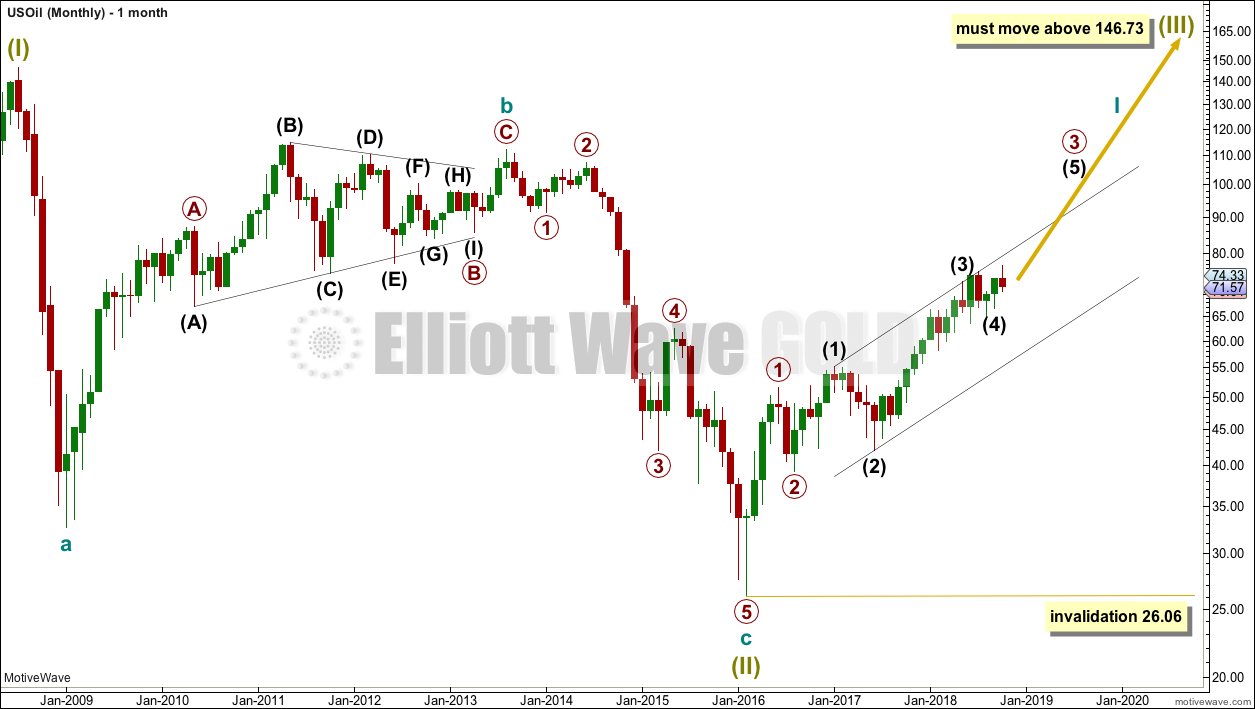
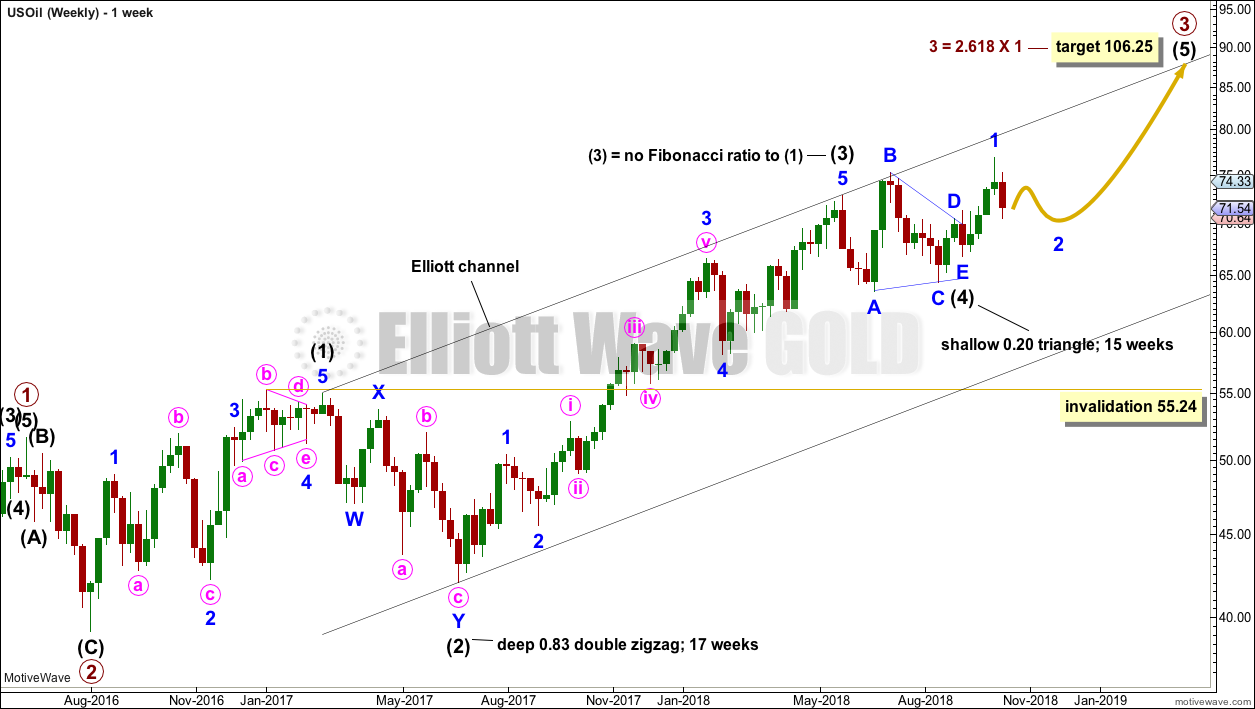
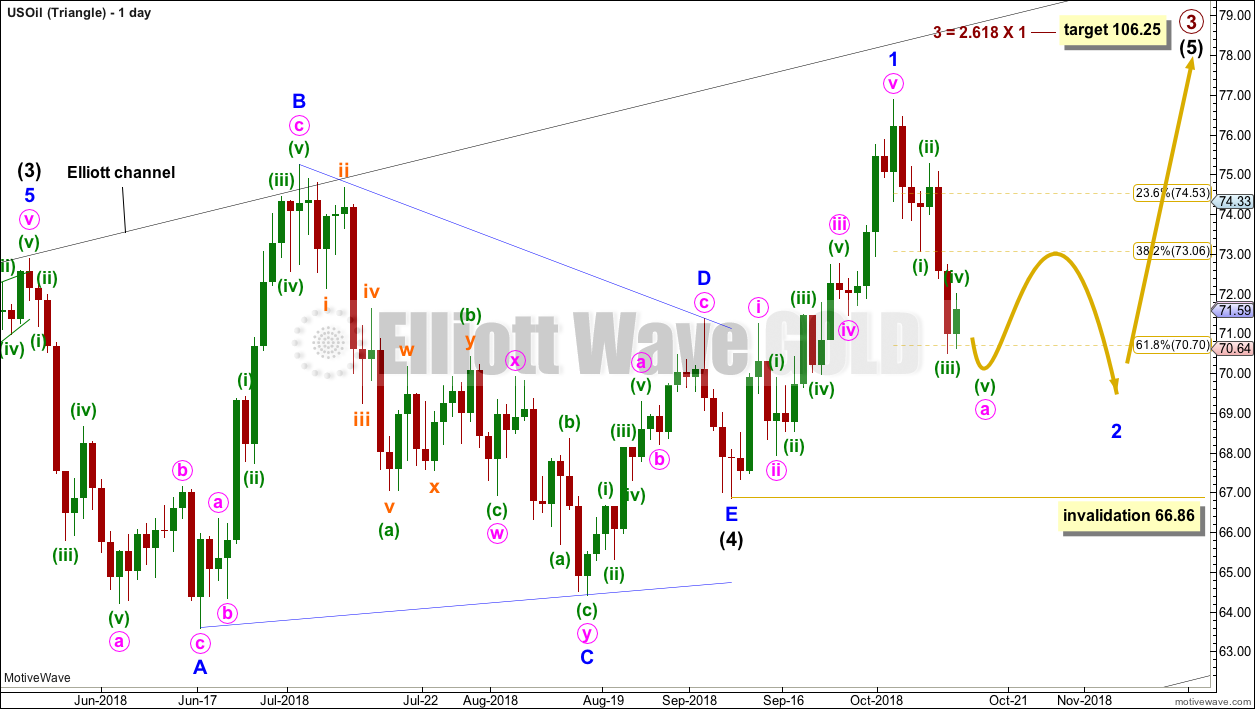
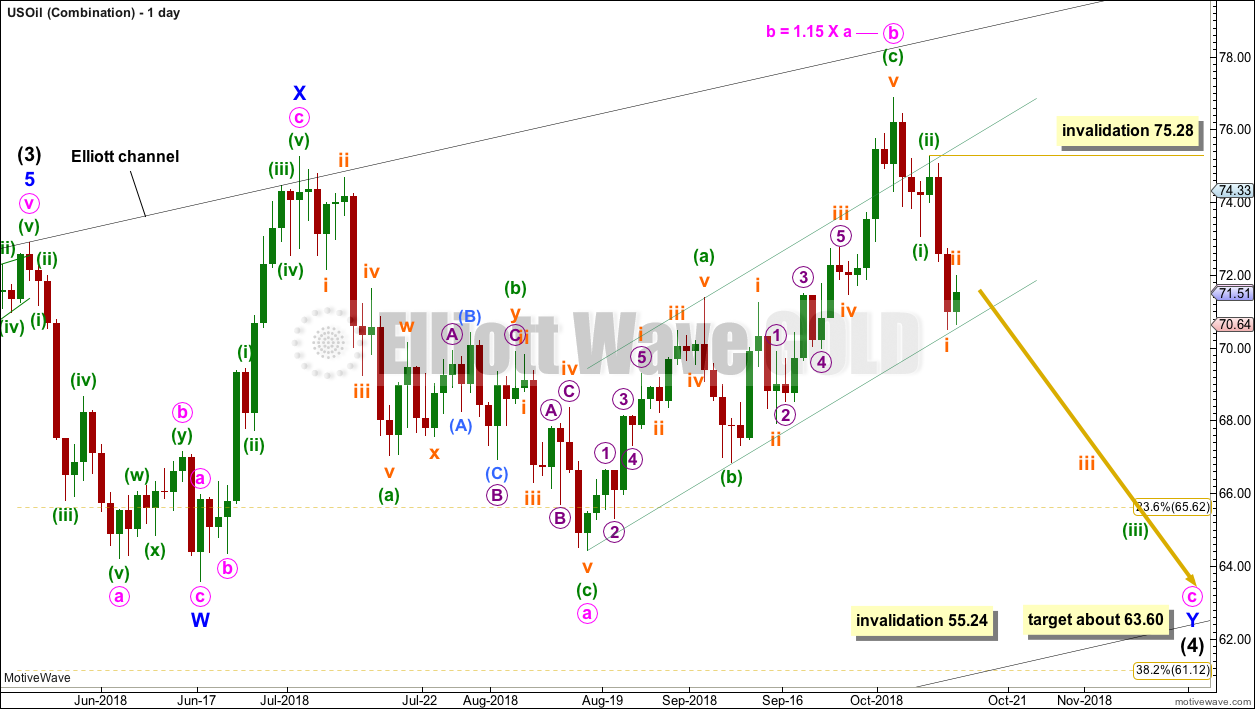
Hey lara!!
For SP500, what invalidation are you watching on Daily to determine if your Alt daily possible flat or combo would apply?
Joseph Lancaster
I’ll post some charts here shortly.
Lara,
Thanks as always for the analysis. I hope the reason you are away from home is for a holiday / vacation. Hope you are having fun.
You have been right on track with the oil analysis. It looks like it will be a good market to get long here in a few days to a week. Unfortunately, it also means I will be paying more for my gasoline at the pump. I had better make some $ in the market to take care of that.
Have a great week.
It’s a “vacation” to see friends and family, and we found some great waves in Gisborne as a bonus. So we are very happy indeed.
Here in NZ we are paying $2.30 per litre. I’ll convert it later, but I know it will make your eyes water. It’s bad. And everyone is blaming our government because… I don’t think they think it through very well.
Oil will have a fantastic buying opportunity coming up very soon if members have not already positioned themselves long.
Wow, I did a conversion of NZD 2.30 to CAD. It works out to CAD 1.97. We are paying CAD 1.20 per liter, in Canada. In the US they are paying about US$ 0.77 a liter ( converted @3.78 liters to a gallon).
Price gouging by oil companies. And yet, if you hold shares of oil companies, you do not seem to get much by way of dividends. If you dig deeper, you will see that the profits are being routed to executive bonuses. Go figure!!!
We are not at home this week and are having some problems uploading the Lara’s Weekly video. It’s a big file.
We have a plan and will be uploading it later today.
Thank you for your patience.
No worries, Lara.
Thank you for uploading the charts and the message, much appreciated.